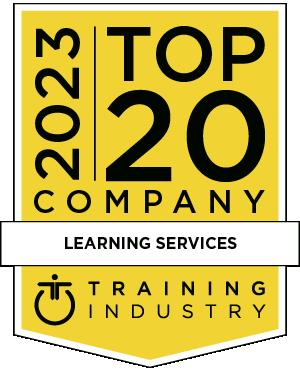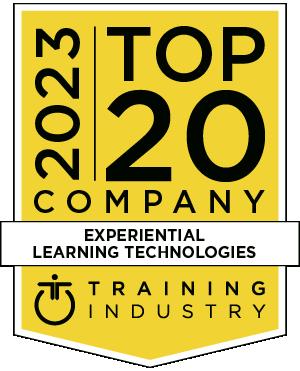














































There are a lot of details to keep track of when developing a training program. From gaining alignment with key stakeholders to developing the content to rolling out the program to the organization, learning and development (L&D) professionals must manage the entire process, sometimes as a team of one. Project management is becoming an increasingly critical skill for L&D leaders to possess.
I recently had the opportunity to lead a roundtable discussion group at the Training Industry Conference & Expo (TICE) this past June that focused on project management for learning leaders. Participants shared their key challenges and other participants shared some tips from their own experience. One tip that emerged as critical to success was maintaining clear and open communication with key stakeholders throughout the development journey. This helped to ensure that the programs were strategically aligned to business goals and that expectations were clearly outlined before the project was kicked off.
The cover story in this issue of Training Industry Magazine highlights the steps that learning leaders can take to ensure their training projects plan are successful. This can serve as a roadmap for new and aspiring learning leaders to use as they develop and deliver training programs for their organizations. Because let’s face it — leading people through
process is tough. Keeping a training project within scope and on time may sound easy but it may feel more like herding cats in execution. Having a solid training project plan in place can help to alleviate common issues and pain points.
This edition also tackles other key challenges, such as growing the internal leadership pipeline, improving the onboarding experience, building an inclusive workplace, creating immersive training that brings learning to life and much more. These articles share actionable tips and best practices to overcome these challenges.
The pace of change continues to accelerate, putting pressure on L&D to deliver training programs — faster. This requires learning leaders to become more innovative and creative on how to improve the delivery of their programs to meet the needs of their learners and the business. This work is challenging, but it’s the passion and heart that learning leaders like you exhibit that makes this work so meaningful.
As always, we love to hear from our readers, so please reach out to our team and let us know how you’re driving meaningful change at your organization!
Michelle Eggleston Schwartz, CPTM, is the editor in chief of Training Industry, Inc., and co-host of “The Business of Learning,” the Training Industry podcast. Email Michelle.
HAVING A SOLID TRAINING PROJECT PLAN IN PLACE CAN HELP TO ALLEVIATE COMMON ISSUES AND PAIN POINTS.


16 20 24 26 31 34
LEADING PEOPLE THROUGH PROCESS: CREATING TRAINING PROJECT PLANS THAT WORK
By Steve FelsonIdentify learner and organization needs and clearly define your scope.
IMMERSIVE LEARNING: CREATING A NEW REALITY IN L&D
By Ithai Stern, Alon Epstein and Daniel LandauVR and XR can enable your learners to perfect their collaboration skills.
THE INCLUSION PARADOX: WHY MANY DIVERSITY EFFORTS FAIL TO FOSTER INCLUSION
By Lee RussellMake your company culture welcoming throughout the employee journey.
THE ROLE OF EXPERIENCE IN PERFORMANCE IMPROVEMENT
By Rich MeschExperiential learning is essential for jobs that depend on soft skills.
GROWING THE INTERNAL LEADERSHIP PIPELINE
By David Hosmer and Susan FranzenAssess needs, set objectives and accurately measure your program’s impact.
THRIVING ACROSS CULTURES: 3 STRATEGIES FOR HYBRID WORK SUCCESS
By Kate SullivanGender, ability and age are just some of the factors that L&D should consider.
39 42 46 50 54
ACTIONS SPEAK LOUDER: THE POWER OF OBSERVATIONAL LEARNING
By Jeffrey HallSeeing others succeed at a task can make all the difference for learners.
7 TIPS FOR TRAINING EMPLOYEES ON CYBERSECURITY
By Matthew GeorgeMake your training and testing flexible and provide support to your IT team.
THE POWER OF STORYTELLING: HOW HUMAN CONNECTIONS TRANSCEND AI’S IMPACT
By
Hope Millerand Elsa Powel Strong Humans remain unmatched at telling compelling and impactful stories.
HOW TO REDUCE COSTS AND INCREASE THE EFFECTIVENESS OF GLOBAL TRAINING
By Nikita AgarwalIncorporate learner feedback into your localization to ensure success.
SINK OR SWIM: IMPROVE ONBOARDING WITH LEARNING ENGINEERING PRINCIPLES
By
Julia Phelan, Ph.D.Onboarding can lay the foundation for long-term learner success.
3
FROM THE EDITOR
By Michelle Eggleston Schwartz, CPTMHaving a solid project plan in place sets L&D up for success.
It’s time to develop leaders who are ready for anything.
Make your workplace more inclusive with these tech tips.
15 9 59 11 61 63 13
By Sam Shriver and Marshall GoldsmithMake your feedback multidirectional with the concept of “feedforward.”
DIVERSITY AND INCLUSION
By Dr. Kristal Walker, CPTMMove beyond compliance checklists and design truly impactful DEI initiatives.
Learn tips on how to navigate an L&D career transition.
CAREER DEVELOPMENT
By Julie Winkle GiulioniCombat burnout and increase productivity by enabling learner connections.
SCIENCE OF LEARNING
By
Srini Pillay, M.D.Learning does not happen automatically just because it’s immersive.
64
CLOSING DEALS
By Sarah Gallo, CPTMLearn why Richardson Sales Performance is positioned for continued growth in sales training sector.
65
COMPANY NEWS
Keep up with the latest in the training industry by reading news from the last quarter.
CEO
Ken Taylor ktaylor@trainingindustry.com
EDITOR IN CHIEF
Michelle Eggleston Schwartz meggleston@trainingindustry.com
SENIOR EDITOR
Sarah Gallo sgallo@trainingindustry.com
EDITOR
Mike Allen mallen@trainingindustry.com

CREATIVE DIRECTOR Amanda Longo alongo@trainingindustry.com
DESIGNER Mary Lewis mlewis@trainingindustry.com
DESIGNER Kellie Blackburn kblackburn@trainingindustry.com
DESIGNER Cassandra Ortiz cortiz@trainingindustry.com
JUDI BADER, CPTM Senior Director of Culture, Learning and Development Willy’s Mexicana Grill
MICHAEL CANNON, M.ED. Vice President, Global Learning and Enablement Rimini Street
BARBARA JORDAN, CPTM Group Vice President, Global Learning & Development Sims Metal Management
CATHERINE KELLY, MA, BSN, RN, CPTM Director of Learning Programs Brookdale Senior Living
SHIREEN LACKEY, CPTM Senior Management and Program Analyst, Office of Business Process Integration Veterans Benefits Administration
SCOTT NUTTER Principal/Owner Touch & Go Solutions
DESIGNER Rylee Hartsell rhartsell@trainingindustry.com
DESIGNER Sha’Meire Jackson sjackson@trainingindustry.com
ADVERTISING SALES sales@trainingindustry.com
MISSION
Training Industry Magazine connects learning and development professionals with the resources and solutions needed to more effectively manage the business of learning.
SUBSCRIPTIONS
MATTHEW S. PRAGER, CPTM Executive Training Manager U.S. Government
MARC RAMOS Chief Learning Officer Cornerstone OnDemand
KELLY RIDER Chief Learning Officer PTC
DR. SYDNEY SAVION Global Learning Futurist Google
KERRY TROESTER, CPTM Director, North America Sales Training Lenovo
NATASHA MILLER WILLIAMS Head of Diversity & Inclusion Ferrara
KEE MENG YEO Adjunct Professor Grand Valley State University & Davenport University
ELECTRONIC: Sign up at TrainingIndustry.com to receive notification of each new digital issue.
PRINT: Print copies are available for purchase at magcloud.com for $17.95.
To order reprints of articles, please contact Training Industry at editor@trainingindustry.com

Aug. 29, 2023, was a beautiful day in Akron, Ohio. At Goodyear’s international headquarters, associates celebrated the company’s 125th anniversary. With the Goodyear Blimp flying overhead, Goodyear’s CEO, Rich Kramer, provided some remarks.
Rich’s comments connected Goodyear’s past to its present and pointed toward its future. While our history presents us an opportunity to revisit the past, it’s also a great time to focus on the opportunities that Goodyear has for the next 125 years.
Reflecting on our CEO’s remarks, it would have been easy to take the alltoo-familiar path of creating a list of development priorities for leaders. But the reality is that these times call for a paradigm shift in leader development. Our focus in learning and development (L&D) needs to shift from prioritydriven to purpose-driven. Given our current landscape, I propose that a purpose-driven approach would be to focus on enabling leaders to be “ready for anything.”
We can begin with emotional intelligence (EQ). Amid so much ambiguity and change, leaders that demonstrate interest and concern for people are more necessary than ever. From EQ, we can expand to other “quotients” that are essential for leaders who are ready for anything:
• AQ: Adversity quotient.
• DQ: Digital quotient.
• CQ: Connection quotient.
Change and disruption is now a reality of organizational life at all levels. For global manufacturers like Goodyear, disruptions in global supply chains, a war in Eastern Europe and the varying levels of inflation are phenomena that leaders and their teams must be ready to contend with daily. Higher AQ leaders are more capable of adapting their teams to operate effectively through change.
Digitalization is now the main driver of everything organizations do, from products and services to internal workflows and business-customer interactions. There is a massive amount of data available now available to teams. This means leaders must direct teams in managing, leveraging and protecting data, as well as using it to evaluate risks.
An example of this at Goodyear is our SightLine technology, which uses data to help fleets and automakers identify and address potential problems before they become issues and understand tire health to enhance uptime and safety. High DQ leaders deliver value by enabling their teams to unlock value embedded in data to the benefit of the organization, its customers and partners.
Today’s teams work across various environments, with many toggling between varying degrees of onsite, remote and hybrid models. Our workforce also includes a greater mix of full-time, part-time and contingent workers. Through all this, effective leaders know how to play the role as master orchestrator, or “connector,” fostering ties among team members and connecting them to internal networks and the larger culture that unites the organization. Goodyear recognizes this complexity and the importance of the leader’s role in managing it, recently releasing an immersive program to ready leaders for leading teams in an evolving environment. Leaders with a high CQ are the key to helping teams stay connected and adapt, no matter what is required to get work done.
Taken together, these four elements — EQ, AQ, DQ and CQ — are an example of the foundation for a purpose-driven framework that simplifies what we expect and want from leaders. Every leader I know has a list of challenges. Shifting to a purpose-driven approach in L&D offers some welcome news for those we serve: “Leaders, we will not be adding anything to your list today! Instead, we are shifting our focus to give you tools to be ready for anything so you can tackle challenges on your list, in whatever form they may take.”
Julian Malnak is the global head of talent development for the Goodyear Tire and Rubber Company. In his role, Julian oversees the development and implementation of Goodyear’s enterprisewide talent initiatives and leadership development programs. Email Julian.

L&D NEEDS TO SHIFT TO A PURPOSE-DRIVEN APPROACH.
Our client needed 25 high-performing IDs...and Yes! we made it happen. Our Talent Solutions team is ready to provide you one or 25 people to help you get your project done—on time!
Meet us: talent-solutions.sweetrush.com
We’re that trustworthy L&D vendor you’ve dreamed about! Solution design and development—well, nobody does it better. Are you ready for effective training your learners will actually enjoy?
Reach out: sweetrush.com/get-in-touch
VR, AR, AI = exciting—and we’ll make sense of it all for you! Ask how you can scale and validate WebVR content to the entire enterprise. Distribute VR and tie to your LMS? Check! Trustworthy, consultative, organized, and innovative.

Jump in: xr.sweetrush.com
Your LMS can be the loved heart of your L&D ecosystem. Simply put, we’re ready to help you fully leverage your LMS. We’ve worked with hundreds and are independent—not bound to any one system.
Please reach out: lmswhisperers@sweetrush.com
info@sweetrush.com www.sweetrush.com
To have diversity, equity and inclusion (DEI) at work means that people, regardless of who they are or what they do for their jobs, feel equally valued, supported, empowered and represented in all areas of the workplace. Workplace learning, particularly in an increasingly common remote and hybrid setting, needs to facilitate the inclusion of all learners. However, it is challenging to know which approach to take or what best practices to follow, especially when learning is augmented by technology. Below are some considerations about how to leverage technology to design an inclusive learning environment.
Online learning can be isolating, so connect your learners with a network of support via collaboration and communication tools. Many such tools support the creation of multiple discussion groups, the ability to post questions and share resources, and the opportunity to mentor others. Make sure that the rules of engagement are clearly established and that people are encouraged to share their life experiences, have alternative perspectives, debate ideas and in general help create a place that is open to different viewpoints.
Universal Design Principles (UDL) champion for accessible and inclusive instructional approaches that consider the abilities of all learners and eliminate unnecessary hurdles in the learning process. Be intentional about how you
use technology — consider the choice of hardware (e.g., mobile devices, laptops, VR headsets); software (e.g., applications, apps, extensions); and technologybased learning environment (e.g., learning management system, content libraries, collaboration platforms) to ensure they provide multiple means of access, representation and engagement.
For example, does your video player allow closed captioning? Is your LMS compatible with screen readers so that people with visual impairment can navigate around the system without problems? For instructional design, I recommend this best practices guide that incorporates UDL.
Providing user control and agency is important for both in-person and remote learning as there are no “typical” learners. People have varied abilities, strengths, constraints, experiences and preferences. These aspects can be dynamic and change depending on the context, content and time. Taking this variability into account, we need to design learning experiences that are flexible and provide multiple support options.
For example, offer different learning pathways, delivery modes/media and pacing (e.g., the option to skip ahead or to slow down and revisit certain content/ activity). It is equally important to provide an opt-out option, especially for data
collection and analysis. Be transparent about user privacy and data ownership: People need to be informed about how data are collected, used and stored. And they should be able to choose not to have their personal data collected.
Participation in online and blended learning requires technology access and a set of digital literacies that are not equally accessible to all learners. This is more so the case with the advance of artificial intelligence (AI) and other emerging technologies such as the metaverse. Technology literacy equips learners with the skills to find credible information, critically evaluate sources, create thoughtful content and also to understand what digital tools are better suited for different learning strategies and purposes (e.g., mobile devices are better for viewing short videos and micro-learning content but not as easy to access an entire course). Embed technology literacy skills into your overarching learning offering so that everyone can start from a base of shared understanding and become adaptable as innovations arise.
Technology can help create and support an inclusive workplace learning environment. It requires commitment, thoughtful design and intentionally removing barriers to access.
Dr. Stella Lee has over 20 years of experience in consulting, planning, designing, implementing and measuring learning initiatives. Her focus is on largescale learning projects including LMS evaluation and implementation, learning analytics, and artificial intelligence applications. Email Stella.

Determine the leadership solutions your organization needs the most. Download the Aligning KPIs to Organizational Goals template to get started.
Years ago, the CEO of an industry-leading pharmaceutical company made a passing comment that wound up sending shock waves down the ranks: “I have never really cared for the term ‘feedback.’”
The dominos that statement set in motion were predictable, dysfunctional and (as long as you weren’t in the middle of the mess associated with the response) comical: “OK, everybody in learning and development (L&D), this just in! The CEO hates the term ‘feedback!’ We need to find out how many times it appears in our offerings and identify alternatives.”
— and in a clear effort to perhaps swim upstream on the topic — consider the possibility that our CEO friend may have been onto something.
The term “feedback” has been with us since the 1920s. It originated as technical lingo in electrical science and was adopted in the 1940s to describe how well — or how poorly — someone was performing a task. In a world where communication and decision-making flowed from the top of an organization downward, feedback became the glue that kept the hierarchy together.
to us a decade or so ago. With bias duly noted, it’s a lot like feedback — only better! First and foremost, it is a positive and upbeat exchange that is multidirectional (i.e., flows down, laterally and up). There are two roles in feedforward:
• Learn as much as you can!
• Help as much as you can!
There are two rules for providing and receiving feedforward:
The first phase of that directive was completed expeditiously. And the results were overwhelming. The term “feedback” appeared tens of thousands of times. Every course that had anything to do with leadership or change or performance management or trust featured “feedback” as the straw stirring those drinks. As the data made its way up the L&D chain of command “Operation Identify Alternatives” went quickly and quietly away.
Of course, the term “feedback” remains ubiquitous. It is not only tied to the terms already mentioned but also perceived as the driving force of transparency, authenticity and truth. Despite all of this
An unintended consequence associated with feedback is the general manner in which it is perceived. When somebody wants to give you some feedback, what is the first thing that jumps into your head? Many of us brace for “a growth opportunity” that (like it or not) will initiate with the critique of something that has already happened that we are powerless to go back and fix.
Another undeniable reality connected to feedback is the emphasis on ensuring people know how to provide it and the assumption that those on the receiving end know how to accept it. With the benefit of hindsight, doesn’t that almost seem backward? It seems like receiving and translating that input into actionable strategies deserves at least equal time.
Enter “feedforward!” Feedforward is a concept that Marshall brought
Don’t talk about the past: Since we can’t change what has already happened, let’s put our energy and focus where we can indeed have an impact.
Don’t judge or critique suggestions : Treat whatever suggestions or ideas you hear as gifts (simply say, “Thank you!”).
It has been our experience that leaders who actively solicit and thoughtfully provide feedforward, build teams and cultivate cultures that inherently have their eyes on the windshield and the horizon in front of them instead of whatever happens to be going on in their rearview mirrors.
Marshall Goldsmith is the world authority in helping successful leaders get even better. Sam Shriver is the executive vice president at The Center for Leadership Studies. Email Marshall and Sam.

FEEDFORWARD IS A POSITIVE AND UPBEAT EXCHANGE THAT IS MULTIDIRECTIONAL.
Take this quiz to see if the CPTM credential can help you further your career in training management.
The world is more diverse than ever before, and companies — regardless of industry or size — must embrace this reality if they want to remain competitive. For companies operating on a global scale, this means accommodating a wide range of cultures, backgrounds and perspectives from both customers and employees. Diversity, equity and inclusion (DEI) training is an essential tool for achieving this goal, but it’s not always easy to implement. An oftenoverlooked step in creating impactful DEI training is understanding the unique challenges involved with the business, the people in the business and the design of the training.
All businesses are not created equal. As a result, purchasing off-the-shelf DEI training could do more harm than good. For example, what works for a small startup won’t necessarily work for a large corporation. You must understand the unique dynamics of the business first, so that the training can be tailored to the specific industry, the size of the organization and the existing and emerging culture. When considering business needs, training managers should consider the following questions to create the most impact:
• What is the organizational structure like?
• Are there any existing diversity initiatives in place?
• Is there a history of DEI efforts within the organization?
A successful DEI training program is built on a foundation of trust and respect. It
relies heavily on one’s ability to connect with each individual participant. To do this, training managers need to understand the people who operate with and within the organization, including their experiences, motivations and needs. This is not always easy but there are tools and techniques to help. Such tools include surveys to assess the current state of DEI initiatives, one-on-one interviews, focus groups and workshops to discuss the needs and challenges of a particular project or department.
It’s equally important to collect feedback from external sources: As customers and stakeholders have an increasingly large influence on business operations, gaining their insights will help ensure that all DEI initiatives are viewed in the most positive light.
When collecting feedback from people within the organization, training managers should consider the following questions to create the most impact:
• How many employees are in the company?
• What challenges do employees face in their roles?
• How does the organization’s culture differ from other workplaces?
• What feedback have external stakeholders provided on DEI efforts?
Once a comprehensive understanding of the business has been established, it’s time to focus on designing training that will have a lasting impact. Before designing any DEI training program, the training manager should take into account the learning objectives and training topics, as well as how they will be discussed
(and by whom) and the exercises that will be used to reinforce the learning.
When considering the actual design of DEI training, training managers should consider the following questions to create the most impact:
• How does the training align with the overall organizational or DEI strategy?
• Does the industry require specialized DEI training?
• What type of activities and exercises will engage participants and create an environment for learning?
• What methods should be used to develop accountability and ensure continuous growth and improvement?
As with any training course or program, a solid DEI training program should have measurable objectives and include specific steps to track progress and ensure that the desired outcomes are achieved. Follow the steps above and you’ll have clearer targets and priorities, less waste and engaged participants who are empowered and supported through lasting behavior change.
Dr. Kristal Walker, CPTM, is the vice president of employee wellbeing at Sweetwater. Kristal is also a facilitator for Training Industry’s Diversity and Inclusion Master Class Email Kristal.

OFF-THE-SHELF DEI TRAINING COULD DO MORE HARM THAN GOOD.
 BY STEVE FELSON
BY STEVE FELSON
In today’s dynamic business environment, crafting effective training project plans is essential. A well-structured plan not only helps identify training objectives but also maps out the strategies, timelines, budgets and resources needed for successful execution. With a comprehensive training project plan in place, organizations can maximize the impact of their training initiatives and drive employee development to new heights.
A successful project plan starts with setting clear training objectives. Objectives should be specific, measurable, achievable, relevant and time-bound (SMART). Clearly articulating the desired outcomes of the training program will help align stakeholders, guide content development and assess the success of the project. Let’s take a look at the essential steps in developing your training objectives and executing your training project plan.
The first step in creating your training objectives is to identify the needs of the organization. It is crucial to determine these needs before exploring the needs of the learners. Meet with key stakeholders and contributors to gather insights and input into the desired results, available resources and budget boundaries.
Next, identify the target audience and understand their needs. This may involve gathering data through surveys, interviews and observations to determine the skills and knowledge gaps that need to be addressed. In addition to understanding your learners’ content needs, engage in a thorough analysis of their demographics, job roles, skill levels and learning preferences.

By tailoring the training program to the specific needs of the audience through the lens of the organization’s requirements, you can design a training program that ensures maximum engagement, relevance, effectiveness and return on investment while achieving optimal results.

Once the needs of all audiences are defined, it’s imperative to conduct a risk analysis so the entire team is aware of potential issues down the road. Has the budget been approved but not finalized? Is one of the key contributors going on vacation for three weeks during the project? There are many issues that can come up along the way during a project.
With the training objectives defined, it’s now time to create the scope statement This scope statement is developed through collaboration with the various stakeholders to define the project objective, desired outcomes, budget and time expectations. Why is a scope statement so important? First, it allows the project leader to keep everyone on target for deliverables, time and expenses throughout the life of the project. When bumps in the road arise, understanding where the project is in reference to the scope allows the leader to expertly navigate and overcome these obstacles.
A training project plan maps out the strategies, timelines, budgets and resources needed for Successful execution.
Inevitably stakeholders and contributors will have ideas for items they want to add to the project, even though these components were not in the original scope. Even if these requests are great ideas, they may not fit the scope of the project. Having a clear scope helps identify if these new requests fit into the purpose, time and budget needs of the project. If new task requests fit into the scope, they should be added to the project. If they don’t, leave them out or adjust the plan with all stakeholders aligned on the time, resource and cost ramifications of the decision.
Once all assessments are complete and the stakeholders have signed off on the project scope, it’s time to formulate a written project plan. This sounds a lot easier than it is. Be aware that many people are not fans of project plans. They would rather do work as it inspires them or as a deadline approaches. That’s why it’s imperative to share the “why” around the written plan.
Understanding that the plan is a guideline to keep everyone on track and not a micro-managing daily task list, most will fall in line with the expectation. Furthermore, many leaders aren’t sure
how to guide the project using the plan and/or inspire use by team members. There are plenty of free and paid resources out there to help with this. A good leader will do extensive research before diving in for the first time.
As you write the project plan, create a project schedule that details major milestones of the project and estimated due dates for deliverables. While writing the plan, it’s important to also identify dependencies, tasks that depend on other tasks to be completed before they may begin. Utilizing a detailed project timeline is a crucial step in effectively managing and executing a training project plan. It helps in organizing tasks, assigning responsibilities and setting realistic deadlines. By breaking down the project into smaller, manageable tasks and establishing a timeline for each, you can ensure a smooth and efficient workflow, leading to optimal results.
One area of planning that is often overlooked is the rollout strategy:

• When the project is completed, how will the program be introduced to the learners?
• Is there a webinar? A roadshow? Train the trainer?
• How will the program be maintained and updated?
• Where will the media be housed?
• Are there technical requirements for the roll out?
There is a myriad of points to consider for the rollout strategy. All options will add time, cost and resources to the project. If this is not discussed and agreed upon at the outset, there is little chance the objectives of the project can be met successfully.
Once the plan components are in place, it’s time to decide how to keep track of the plan. Many project leaders will use project management software or a spreadsheet document. If you haven’t used one of these before, don’t worry. Just think about what level of detail and technology you want. There are plenty of software options out there with a range of features, prices, methodologies, etc. Best of all, most offer a free trial so you can try them on for size.
Make sure you like the look and feel of the software. You will spend a lot of time in the program, so its look and feel should bring you some joy. If you decide to go the spreadsheet route, there are many templates available at no charge on the internet. Once the plan has been written, present it to the stakeholders to ensure their buy-in. Everyone should be aligned on what this project will do and what results it will produce.
Now, it’s time to execute the plan. The lion’s share of people, resources and budgets are deployed during the execution phase of the project. It is critical for the project leader to keep a close eye on things to make sure the work being done is on-track with the scope goals and deliverables. Coordinating tasks and resources through a written project plan will keep the work on budget and help safeguard against scope creep.
Many leaders choose to hold weekly or bi-weekly project meetings where key contributors update the written project plan and report on their progress in the live session. This enables all contributors to stay in-the-know on key information and timelines. It also provides an opportunity to workshop roadblocks and challenges together. It’s common
to not invite stakeholders and sponsors to these project meetings. Instead, a regular cadence of steering meetings with that audience allows them to remain informed on progress without having to sit through all the minutiae of the day-today work.
As the project leader, stay close to the content being created. While you don’t want to micromanage the process, it is the leader’s role to validate that the materials being created address the stated objectives of the project scope and meet style, tone and other internal guidelines. Check in often to ensure large amounts of work do not have to be recreated.
Once the plan is in place and the project plan milestones are being checked off and oversight is being applied to the various tasks, the project leader must continue to communicate with all parties. While this is not a specific line item on a project plan, this communication is what ensures that the work being done continues to be relevant and will be well-received by all audiences.
Using the aforementioned project and steering meetings is a great place to start. Also, decide on a regular cadence of information. Is there a weekly email?
• Conduct a training needs analysis.
• Conduct a risk analysis.
• Create a project scope statement.
• Write the project plan.
• Get stakeholder buy-in and sign-off.
• Execute and validate plan components.

• Communicate, communicate, communicate.
• Roll out the program to the learners.
A monthly webinar? Whatever you choose, make sure everyone understands the cadence of information flow so they may remain informed and ask questions as the work happens, not at the end when everything is presumed to be finished.
As you can see, creating and executing a project plan is no small task. It takes careful thought, collaboration, planning and communication. All of this takes time and effort. Consider all the starts and stops, double work and missteps that happen without a plan.
Without a plan, what chance does the project have to come in on budget and on time without over-taxing your team and resources? Again, if you haven’t done a project plan before, don’t worry. Even a bad project plan is better than no plan at all. Using the process from start to finish will most definitely produce a better quality of work and materials that impact your learners and the entire organization for years to come.
Steve Felson is currently the vice president of training and development for Home Franchise Concepts, a franchisor of 10 national home service brands. Steve has spent more than three decades in multiple industries training and educating business owners and leaders on how to create profitable, growth-oriented businesses. Email Steve.
Be aware that many people are not fans of project plans.
is going through an organizational transformation that requires communication across all departments. It has become clear that teams in some departments are not communicating effectively, severely hindering the change process. Feelings of mistrust have surfaced. The chief learning officer (CLO) of the company has decided that an intervention is required. She needs to gain the confidence of the team members to improve the flow of information across silos in a constructive manner. Instead of hiring an organizational consultant or publishing an online tutorial, the CLO invites team members to participate in a virtual mission to the surface of Mars where they confront unexpected challenges. In the safety of their own workspace and without any travel expenses, participants put on a virtual reality (VR) headset and are instantaneously teleported to the Mars basecamp, where they receive their mission briefing.
Very quickly participants who are undertaking the mission stop asking themselves “What do financial services have in common with saving humanity on Mars?” and start asking constructive questions like “What aspects of information should be
effective solution as a team?” It quickly becomes evident that participants are having fun and being creative while the immersive learning system collects crucial data about their choices and decision-making strategies as competing teams.
Immersive learning opens new frontiers and capabilities that have never been accessible before in corporate learning. Today, by virtue of accessible turn-key solutions, CLOs and education professionals can drive impact while boosting learning engagement, knowledge retention and learner compliance through data-driven synchronous and asynchronous learning.
Immersive learning is a simple yet powerful methodology that can engage learners in an absorbing virtual environment where they are active in a scenario that challenges them to make decisions and explore the environment in a truly authentic way. Participants can be immersed in ultra-realistic scenarios, where they can enter and act upon sensory rich environments
different interfaces.
Most people would have seen or experienced people playing virtual games while wearing headsets covering the upper part of their faces and holding attachments in their hands. For entrepreneurs designing immersive interfaces, the challenge is to move the needle from commercial apps and games into the blue ocean of learning and development (L&D). In this article, we are going to argue that immersive learning solutions are on the cusp of a revolution.

Extended reality (XR) headsets have been around for years, but only recently have they entered anything approaching mainstream use thanks to all-in-one devices and reduction of costs alongside improved performance. In the early days of development, rudimentary desktop headsets were


IMMERSIVE LEARNING IS A SIMPLE YET POWERFUL METHODOLOGY THAT CAN ENGAGE LEARNERS IN AN ABSORBING VIRTUAL ENVIRONMENT THAT CHALLENGES THEM TO MAKE DECISIONS.
endorsed by pilot schools, airlines and Air Force academies. Participants got up to speed on flight controls and cockpits, takeoff and landing patterns. The systems were expensive to buy and the scenarios difficult to create. Furthermore, participants were expected to jump into reallife situations in parallel to their virtual training.
In the corporate arena, L&D professionals are continually challenged to train their workforce using traditional systems that were never designed for hybrid work, scalability and sustainability. Furthermore, L&D professionals are often constrained by a highly complex competitive and regulatory environment in today’s digital landscape. Breaking through traditional silos that weigh down employee productivity is exactly where immersive learning capabilities can provide added value.
Using an immersive learning platform, L&D professionals can measure the performance, cognitive abilities and personality traits of their employees to help them grow in the right direction, by personalizing the learning process. Moreover, L&D professionals can do this without having to get bogged down in individual questionnaires or self-reports which could, for example, trigger massive paperwork under personal data protection regulations.
Given an introductory training course, L&D professionals can oversee the design, development, production and enhancement of a highly sophisticated and secure software suite dedicated to the needs of their workforce. At the same time, customized content is bundled into a software platform and distributed at the exact time and place designated by the L&D departments and learning professionals. Founded on advanced immersive technologies, AVRIS provides immediate access to data-driven knowledge and experience, which are
strengthened by a global community of lifelong collaborators.

Groundbreaking? That’s a big claim for a startup. Let’s unpack that assertion. Traditional learning solutions typically begin and end with the final answers and response times of participants. By contrast, analytical engines that receive inputs from immersive experiences are able to measure every single interaction learners perform while wearing the headset. Simultaneously, the engine records behaviors by calculating gaze direction, time lapse, decision strategies, and the location and angle of the head and hands at an astounding precision.
When a participant exits an immersive environment, the immersive analytical engine goes to work at lightning speed and returns a richer and far more comprehensive data set than a traditional method could possibly provide. Having gleaned tens of thousands of data points per participant, the machine deep dives into the behavior of candidates, providing insights about them with far greater rigor, accuracy and robustness than other approaches, digital or human driven. Debrief and reflection are enriched as they are based on real-time data, ultimately impacting the participant’s capabilities.
Learning how to solve problems under stress, for example, is a skill
that can be learned and enhanced in an immersive environment. In the past, L&D professionals used questionnaires and self-reports to discover an employee’s susceptibility to stress or other emotional situations. In a virtual environment, the engine can analyze human behavior itself. How is this achieved? Instead of asking individuals how stress affects their performance, learning professionals will let the behavioral analytics engine do the work for them. Participants enter simulated virtual experiences where real-world problems need to be solved. They gain knowledge through their interaction with other participants who have different skill sets and experiences.
With the continuous growth of immersive learning solutions and offerings, corporate partners and individual learners are provided with a growing range of just-in-time training solutions. Such solutions can improve the experience curve of employees, thereby increasing the competitive advantage of their respective companies. Gamified, interactive and data-driven virtual scenarios can get employees up to speed on the job much faster than simply adding new development training components.
The acronym, XR, is used to describe the different types of immersive interfaces on the market, including:
• Virtual reality (VR) dissociates the user from the current reality, sending you to another place or situation.
• Augmented reality (AR) is used in a natural real environment but provides additional layers of data and visuals for the user.
• Mixed reality (MR) is a mix of VR and AR, providing visibility on both the real environment but also enables detachment and full immersion.
Other types of interfaces and devices are emerging in this fast-growing market, with extended reality (XR) startups in the United States raising $208 million in June 2023.
They reduce the length of time it takes between existing training programs and their application by employees on the factory floor or in the boardroom. Costs are cut and quality is improved.
Moreover, the analytical engine can transform the lifelong learning experience of participants, making for a talent-retention story. A group of psychologists, neuroscientists and
data scientists design simulations for specific situations, which are then subjected to an extensive internal validation phase. New and enriched learning experiences are being developed and added to the portfolio regularly.
Meanwhile, the virtual trip to Mars was a major success. As a result of immersive learning, the organizational transformation at the financial services provider was completed on time and within budget. Moreover, a lifelong learning process has begun within the firm as the CLO has implemented immersive learning solutions across the organization.

Investment in the development and growth of the company’s greatest asset is obviously a worthy effort. But it is up to learning professionals to choose
impactful, engaging and cost-effective methods to fulfill organizational objectives. Immersive learning presents an unprecedented combination of these, and thanks to recent technological breakthroughs, has become accessible as well as affordable.
Ithai Stern is academic director of INSEAD’s VR immersive learning initiative, professor of strategy at INSEAD, and The Akzo Nobel Fellow of Strategic Management.
Alon Epstein is a co-founder of AVRIS Technologies and the director of immersive content and learning development.
Daniel Landau, Ph.D., is the co-founder and CEO of AVRIS Technologies. Email the authors.
GAMIFIED, INTERACTIVE AND DATA-DRIVEN VIRTUAL SCENARIOS CAN GET EMPLOYEES UP TO SPEED ON THE JOB MUCH FASTER THAN SIMPLY ADDING NEW DEVELOPMENT TRAINING COMPONENTS.
https://bit.ly/3qotbmA





You will want to work with the same team!


he great irony of organizational diversity and inclusion initiatives is that the “inclusion” aspect is often excluded.
Typically, diversity initiatives will focus on the need to provide equal opportunities, employment law compliance and the merits of diverse recruitment. These are of course highly important. But attracting and recruiting a diverse workforce is only half the battle. You then have to create an inclusive workplace in which people are accepted as individuals, regardless of their differences and where they feel their contribution is valued.
If any of your employees do not feel part of the organization, their personal performance is likely to decline. Exclusion acts as a psychological distraction. It plays on people’s minds and can even lead to paranoia as individuals wonder “What’s wrong with me?” Their stress levels can rise, they’ll avoid collaboration with others and their engagement will plummet. Absenteeism and attrition will increase.
By Lee RussellConsequently, productivity, innovation and agile working — the ability to adapt quickly to changing circumstances — can all suffer. Put simply, if your diversity and inclusion initiatives are focusing primarily on the need for diverse talent, rather than how to make people feel included, aspects of your business are under threat.
You can assess your organization’s inclusivity by examining three areas:


• Culture: Does your culture support inclusion? What are you doing that makes your employees feel included? What makes people feel excluded? Your culture is influenced by the behavior of your senior managers, the stories they tell, the way they manage people and the example they set. What behaviors are driving your culture?
• People: Do your people really feel included? Engagement surveys will provide a general temperature check but what are people actually saying about their jobs, and the organization, around the coffee machine and on social media? That’s where they’ll express their true feelings.
WHY MANY DIVERSITY EFFORTS FAIL TO FOSTER INCLUSION
DIVERSITY AND INCLUSION SHOULDN’T BE ABOUT SIMPLY SETTING TARGETS AND QUOTAS.
• Processes: Do your processes, including compensation and bonuses, support inclusion? Are they fair? Do they encourage the right behavior? Could they inhibit inclusion?
If your organization has an issue with inclusion, here are 10 approaches that might address the problem:
1. Mission and Values: If your employees are not aligned with the overall purpose and values of your organization, they’ll never truly feel part of the business. Your mission should showcase what you stand for — and your employees should feel inspired to achieve it.
2. Recruitment: While supporting diversity, your recruitment process should target candidates whose personal values match those of the organization. Training for hiring managers should be broadened from equal opportunities and employment law to include the interviewing skills needed to identify candidates who are likely to feel included in your organization.
3. Onboarding: Instead of simply giving new recruits a diversity policy to read, create a training intervention on inclusion. This should highlight why it’s important to value people’s differences — and how to do this.
4. Communication: Share details of your operational performance and your plans for the future with employees. Let them feel included in the direction of the business and in the decisions that underpin the organization. Initiate “town hall” meetings, where employees can meet and question senior managers.
5. Leadership: Your leadership team should role-model inclusive behavior. Consider creating a module for your leadership development programs on inclusion. The challenge here is that your leaders will think they’re inclusive. No one wants to be seen as sexist, racist or homophobic. But their role in shaping the culture of your organization must be emphasized.
The attitudes they display are also important. If your employees look at your leaders and think it’s never going to be possible to be one of them, they’ll feel excluded.
6. Line Managers and HR Business Partners: Managers at all levels — including first-line managers, supervisors and team leaders — have a responsibility to look for signs of exclusion (or not participating fully) in their teams. They should help each person to understand how their work contributes to the organization’s mission. They can ask people directly: “Do you feel included in what we do as a team?” If people are fundamentally against the values of the organization, they’ll probably leave. But there may be issues or blockers which are making them feel excluded that can be easily addressed. HR business partners have a similar role in enabling inclusion in the organization.
7. Performance Management: Inclusion can be integrated into your performance review process. This should be a forum where employees can openly discuss any issues they have around fairness, transparency and equality of opportunity.
8. Succession Planning: Some employees feel inhibited from applying to management roles in their organization because they believe these are restricted to certain people, for example, those of a certain gender or a certain background. The challenge here is to ensure that all employees feel that their internal applications (for roles they’re capable of undertaking) would be welcomed.
9. Exit Interviews: When people are leaving, they’re more inclined to be honest about any issues that have prompted their departure. Ask them if they are leaving because they felt excluded or held back in some way.
10. Development: Inclusion awareness training should be integrated into your existing diversity training programs. It can even be added to team development programs. A team may not be achieving high performance
because one or more of the team members feels excluded either from the team or from the organization. Development interventions should ensure that individuals are equipped with the right mindset, toolset and skill set to be effective in their role. This is key to helping them feel part of the organization.
If your diversity and inclusion initiatives are focusing primarily on the need for diverse talent, rather than how to make people feel included, aspects of your business are under threat.
Diversity and inclusion shouldn’t be about simply setting targets and quotas. It should equip your organization with a variety of viewpoints and perspectives, so you can better understand and meet the needs of diverse customers. Yes, your organization can benefit from recruiting a diverse workforce — but you’ll only realize those benefits if your people actually feel included and valued enough to contribute.
We all deserve the opportunity to work in a safe, supportive and inclusive environment where we can achieve our potential. Is anything inhibiting this in your workplace? If so, strive to address it.
Lee Russell, a director of client solutions, has worked within the consultancy space for over a decade, with a specialty in helping people and teams to reach and sustain their peak performance. His creative and pragmatic approach, combined with his extensive experience in leadership development, allows him to deliver a variety of blended solutions, which provide long-lasting results for clients. Email Lee.

Why is it that people can learn, pass tests and demonstrate their knowledge, yet still not change their behavior?
It’s an age-old question and one with a lot of potential answers. One of those answers is that we possess knowledge but lack experience. We sometimes call it the knowing/doing gap. Even though people know what to do, they are not able to execute.
Leadership development is a great example of this challenge. Leadership behaviors are often not hard to understand; they are focused on basic human motivation and psychology. Leadership books are read by millions. Many say they are inspirational and motivational. And there’s certainly no shortage of them: A search for “leadership” on Amazon.com yields more than 50,000 titles.
So, why are there still so few truly effective leaders?
Because leadership behaviors may be easy to understand, but they’re hard to execute. We learn the rules, but we haven’t yet experienced the ramifications. Why is leadership difficult? Because leaders are people who doubt their own decisions. Because it’s fairly easy to internalize the rule of effective feedback but can be difficult to look someone in the eye as they sit across from you. Because as human beings, we can find it difficult to provide both praise and criticism. So, it’s not because leaders don’t know how to act; it’s because there’s an emotional reason they don’t want to. And until we address those emotions, we aren’t going to see behavior change. Good learning experiences make you feel the same emotions that you’ll feel when you do it in real life.
We don’t learn to drive exclusively by sitting in a classroom; we get in the car and drive. And who wants to fly with a pilot who passed all the written tests, but never demonstrated that they can actually fly an aircraft?
Aircraft pilots aren’t the only profession that requires experience to do the job. There are several professions that have experiential learning “baked into” the qualification process:
• Trades typically require apprenticeships before certification.
• The military engages in simulated missions.
• The medical field has several tiers of experiential requirements.
What is the common thread in all these professions? They are all jobs where the impact of failure is profound. And they all require a certain “muscle memory” to make decisions quickly and with confidence.
There’s a reason why learning from experience is effective. Learning focuses strongly on the what, while experience focuses on the how: “How will I actually do this?”, “How will it feel to me?”, “How will it impact others?”
How does experience bridge the knowing/doing gap? The CAPE model is a simple way of expressing the benefits of learning from experience, by helping you gain:
• CONTEXT: How does my behavior impact my role and the roles I interact with?
• APPLICATION: When and where do I use this behavior on the job?
• PRACTICE: Try the behavior in a low-risk environment to gain confidence and perspective.
• EXAMPLE: What does it look like when I do it right? What does it look like when I do it wrong?
Role-play is one of the most common practice methods in jobs with high interpersonal skills requirements, such as sales. Ask most salespeople, and they’ll tell you how much they dread role-play exercises. And it’s understandable why; role-play can be uncomfortable and require quick creative thinking. And these are exactly the elements that make the job difficult. So, the discomfort of role-play can help prepare you for the discomfort of a real selling situation.
Role-play is a type of systemic, deliberate practice that focuses entirely on honing and performing improvement. Deliberate practice can be difficult and uncomfortable because it is focused on testing the limits of your capability until you improve.
For musicians, it might be playing a difficult passage repeatedly until it can be executed flawlessly. For salespeople, it might be practicing your sales conversation until you can do it without thinking about it.
Ultimately, the best experiential learning has some form of role-play incorporated. Roleplay is a form of simulation, one of the most common types of experiential learning.
Experiential learning doesn’t necessarily require any technology at all — apprenticeships have been with us for thousands of years and role-plays and paper-and-pencil simulations predate computers. But many technologies can make gaining experience more engaging and immersive. Here are a few technologies in use today:
Simulations have been with us for many years, and technology-based simulations are a comparatively recent addition. The goal of simulation remains the same, though: Create a realistic environment where people can practice new skills in a relatively risk-free environment. In truth, most experiential learning approaches involve aspects of simulation.
Most people are familiar with flight simulators, but there is a broad range of simulations: Role-plays are simple simulations that focus on scenarios with high human interaction, like selling scenarios. Systems simulations allow
you to explore the intricacies of complex systems without the risk of destroying valuable data or damaging equipment.
Branching storyline simulations are becoming increasingly commonplace (largely due to the advent of software that simplifies building them). This type of simulation follows an often-complex decision tree, allowing users to make decisions, see their impact and make
opportunities for human interaction, coaching and user-created scenarios that may provide a more robust experience overlay to the simulated experience.
Virtual worlds are designed to be collaborative. While some apps focus on the kind of backchannel communication that programs like Zoom and Teams already do well, the best ones focus on getting groups to collaborate on a project or a task, adding to the emotional impact of the experience.
Virtual reality (VR) is a particularly immersive form of simulation. Most VR systems make use of 3D goggles and immersive audio to create an experience that can feel a lot like “being there.” This opens up a new world of experiences, which might be difficult or impossible to create with other types of simulation. For manufacturing environments, VR can simulate the internal workings of machinery, which might be otherwise inaccessible. And for interpersonal skills, VR can ramp up the reality factor of feeling there is an angry, sad or upset person sitting across from you.
new decisions based on that impact. Branching storylines are appropriate for many types of business skills, including leadership decision-making.
Not that long ago, we called the metaverse “virtual worlds,” or environments that supported human interaction in a variable, somewhat realistic environment. Pioneering virtual world technologies like Second Life allowed for incredibly robust, user-determined environments, but were intimidating in their technological complexity and steep learning curves. Business-based virtual world platforms were often easier to adopt, but often diminished the features that made virtual worlds so intriguing in the first place.
Virtual worlds are back, rebranded as the metaverse, but they offer a similar value proposition: A persistent, 3D world where people can interact with each other, with the environment and with stories and scenarios created in-world. Like simulation, it offers opportunities to practice in a safe environment and gain some virtual experience. However, the metaverse may also offer increased
VR still has some significant barriers to entry, including the cost and complexity of making the VR headsets available and understandable to users. The cost of developing VR programs continues to be high, but the market continues to produce VR development systems that are more and more accessible to the average developer. It’s likely we’ll see more applications of VR in the future.
The modalities mentioned are pretty cool, but do they really make a difference?
How are organizations using experiential learning? Here are a few examples:
• A major telecommunications company was anticipating the possibility of a labor strike. They had a plan to continue operations during a strike but had never executed it before. The telecom created a “strike simulation” to help people practice for the future state so they would be ready when a change occurred.
• A large retailer identified that when buyers were promoted to merchandising managers, about 50% failed within the first year. The most common reason given was a mismatch of expectations; the job was very different from what buyers thought it would be. The retailer created a merchandising manager simulation to allow high-potential buyers to experience a year in the life of the job before competing for it. A significant percentage of buyers chose not to pursue the merchandising manager role after using the simulation because they knew they would not be happy doing it, driving up retention rates for those who chose to stay in the process.
• Walmart created a VR program to simulate the intensity of a Black Friday sale, to prepare store personnel for the crowds and the demands of often frustrated or angry customers.
For professional development and personal growth, there is no substitute for experience. Experience helps us build muscle memory for tasks that we face often, exposes us to the likely outcomes of our decisions, and allows us to begin to experience the emotions that can make decision-making difficult, even when we know the “right” answer.
The modalities discussed in this article can help accelerate experience in simulated environments. While digital experience will never be quite the same as real-life experience, it can make us better prepared for the challenges and opportunities we face in our careers.
Technologies continue to morph and change, but technology is just the vessel, the tail wagging the dog. The experience is what matters.
Rich Mesch has been working in the field of experiential performance improvement for over 30 years. He is the co-author of “The Gamification of Learning and Instruction Fieldbook,” and is currently the vice president of advisory services for Performance Development Group Email Rich.
There are a lot of intuitive reasons why simulations work, but are there metrics that demonstrate that e ectiveness? Actually, there is. A meta-analysis of studies from the University of Colorado, Purdue University and a large telecom showed:

improvement in cognitive performance (information recall and application)
increase in decision-making confidence. %




Many organizations grapple with the question: “Should we build or buy our leadership talent?”
When an organization’s strategy is to build a robust leadership pipeline, it is not always a straightforward endeavor. Let’s take a look at some key considerations for laying the groundwork for a successful internal leader development program, and how to assess the impact of your leader development efforts.
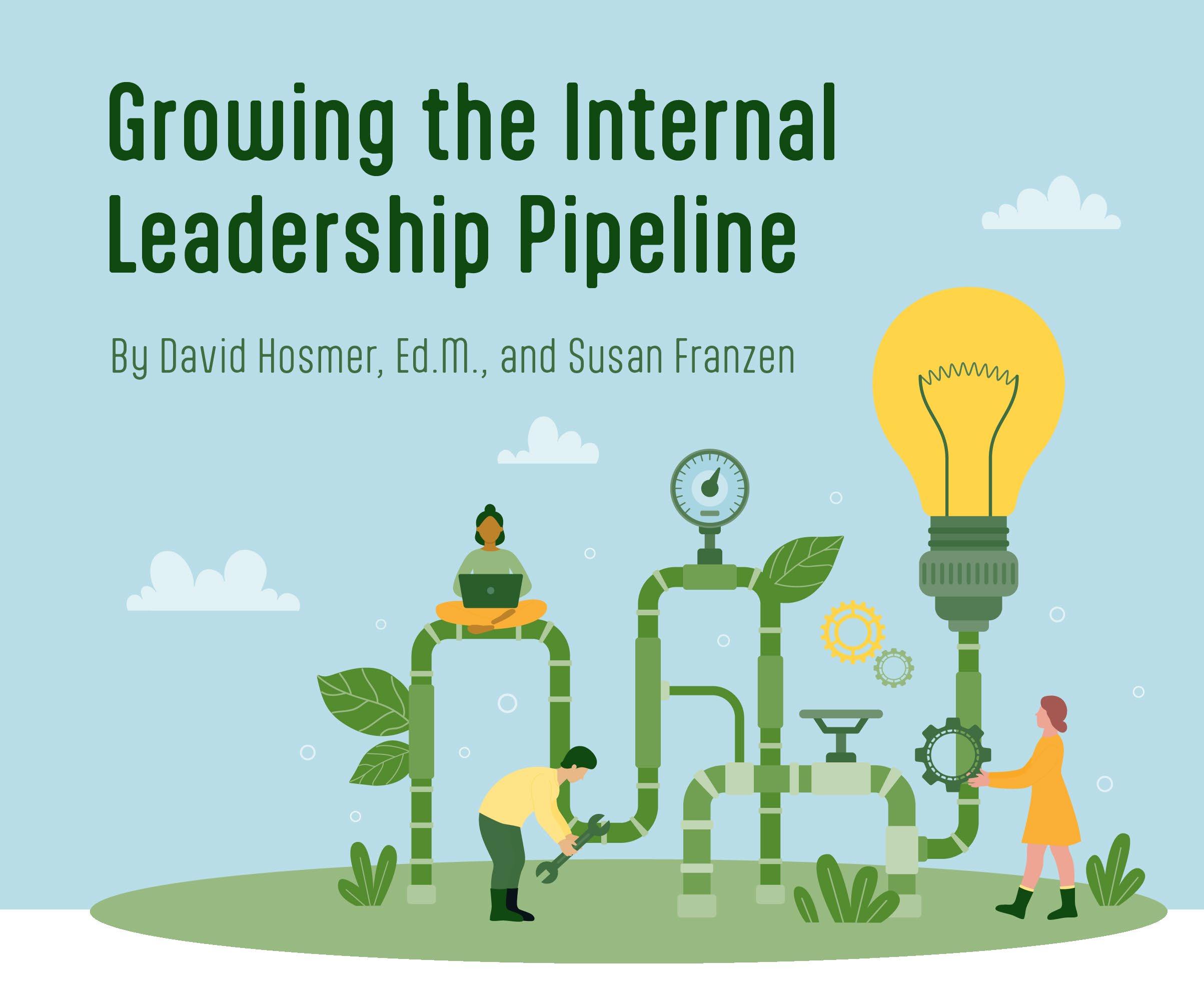
We must begin by addressing some critical questions, regardless of whether you build or buy. Here are a few to get started:
• What is the gap between the skills and number of leaders and managers we
have today and what we will need for business sustainability?
• Why now (i.e., is there turnover that requires us to have new leaders in the queue)? Do we anticipate significant changes in our business (e.g., new markets and domestic/global market expansion)? Will we engage in mergers/ acquisitions, etc.?
• What is the timing? Do we need more leaders to be ready now or for anticipated business needs?
• Are there abilities and knowledge unique to our organization that are difficult to find in the market?
• Can we hire for strong leadership skills, then train for the specific
technical (industry and products) knowledge?
Your needs assessment will inform your leadership program objectives, content and ultimately the measures, and these will apply whether you develop talent internally, with the help of a vendor, if you pursue external leadership hires or employ a combination of all of these.
Your objectives should emerge from your assessment. These become the basis for your impact indicators later in the program. For example, if increasing retention is an objective, then capture your baseline and track changes to
retention over a specific timeframe. Another objective might be to reduce recruitment costs, which can easily be measured with baseline costs and savings by hiring and developing within. Although developing leadership talent can be expensive, other gains (such as retention and recruitment savings) could offset costs. Employee turnover can also result from bad hires as leaders have a profound impact on culture.
You can decide to create your leadership development internally (if you have the resources) or in partnership with an experienced reputable vendor. Even if you opt to hire leaders and not build, consider providing an onboarding development plan for new-hire leaders. It will save time and frustration for newcomers to learn company-requisite culture, processes, policies and other nuances — especially in large or complex organizations.
as a fix for performance issues. Also, your budget might dictate the limitations to the number of participants.
From your assessment, determine what level managers or leaders will be invited to participate. Will you have mixed levels or homogenous peer groups? Will your strategy be open enrollment or a oneor two-year cohort? Ensure diverse participation: Heterogenous groups will afford rich learning by members of differing functional areas, backgrounds, experiences and geographies.
If you decide to source candidates from an internal pool, they can emerge from different levels in an organization (e.g., individual contributors, supervisors, managers and leaders). Here are five factors to consider when planning your leaders’ development:
• Core management skills for new managers are still relevant, particularly for individual contributors transitioning to a people management role. They must learn to accomplish work through others. This transition can be a challenge for technically inclined employees who get promoted to manager as they might think, “It’s easier to do it myself,” in situations where delegating would be more appropriate.
• If an individual is elevated to serve as manager over their former peers, the transition can be challenging, depending on how the newly appointed manager handles their relationships.
development, budget, decisionmaking authority, mentoring, etc.
• Managers should learn leadership skills as they develop into more experienced managers. This is taking the long view of preparing managers for future leadership positions in your organization.
Some organizations recruit external college graduates and develop them internally, like in leadership development programs (LDPs or GLDPs for the graduate level). These programs typically require high grade point averages, strong recommendations, solid applications and rigorous interviewing among other criteria in the selection process.
LDPs can be structured by tapping internal resources for various learning components, such as subject matter experts (SMEs) or functional leaders or external experts. At a minimum, LDPs still require dedicated resources like a program manager, budget, senior sponsorship and university relationships.
As a note of caution, SMEs are often promoted into manager roles without adequate preparation. Subject matter expertise does not equate to leadership skills. Many technically inclined managers fail as managers or leaders. A long view is important, as managers need both managerial and leadership skills for current and future roles.
Determine who and how you will select your program participants. Will you have an application process? Will highpotential candidates be the primary audience? Generally, programs requiring copious resources should not be used
• Individual contributors do not learn how to become managers simply by having the title. Careful consideration must be given as to why an individual is being selected for a manager role. Merely having strong technical expertise is not enough. An assessment of interactive skills (e.g., “power skills” or “soft skills”) and a development plan is key.
• Provide resources to set up new managers for success, including adequate resources, such as
Presumably, experienced managers within your company will have knowledge and expertise of your specific products and services. This can serve only as a foundation for future leaders and can be a potential strength over external candidates. However, this is not enough. Despite debate about the differences in definition between manager and leader, the need for strong soft skills is without question.
Furthermore, for executive-level leaders, we find that traditional programs are no longer adequate preparation for today’s and tomorrow’s challenges.
Leadership development should not be approached as a “quick fix” of generic workshops.
As Mihnea Moldoveanu and Das Narayandas write in Harvard Business Review, “companies are seeking the communicative, interpretive, affective, and perceptual skills needed to lead coherent, proactive collaboration. But most executive education programs — designed as extensions of or substitutes for MBA programs — focus on disciplinebased skill sets.”
It falls to learning and development, then, to bridge the gap between what these traditional programs convey, and the broader interpersonal skills tomorrow’s leaders will need to be successful.
For mid-managers, a variety of competencies have emerged as critical for success in the ever-changing business climate.
Here are some core leadership necessities:
• Visioning and strategic thinking.
• Adaptive leadership and change.
• Optimizing hybrid work.
• Leading with empathy.
• Engaging others.
• Emotional intelligence.
• Leading across boundaries.
• Leading inclusive, employee-centered cultures.
Having identified clear objectives enables you to determine the success of your program. If you have met your objectives, your program has had an impact on what is important to your organization.
Professional development should not be approached as a “quick fix” of generic workshops with the hope that new leaders will transition easily and have learned what they need to lead. In the
Leadership Transition Report published in 2021 by DDI, 55% of leaders having a difficult transition said they got leadership training, and only 14% said the training they received was high quality. By comparison, 30% of leaders with smooth transitions considered their development high quality.
There are many points of impact that affect a leadership transition. A blended cohort learning experience including individual leader assessment, new content, feedback, coaching and applied learning for new and experienced leaders will afford rich diverse learning experiences.
Let’s revisit how to identify your program’s determinants of success when you write your program objectives. A structured program results or impact map is a good way to capture these measures. Here are questions to help you:
• What are the most critical outcomes to measure? Attempting to measure too many factors might create unnecessary extra work.
• Who cares? Identify your key stakeholders and what they deem most critical for leadership development and performance. Be wary of pressure to over-collect data and overanalyze.
• What can be measured? 360-degree feedback and focus groups can reveal behavioral changes. Action plans developed and implemented in the field throughout the program can serve as real-time measures of how participants employ what they learn. Whereas end-of-program surveys will measure participant opinions of the program but not necessarily behavior change. Post-program data can be invaluable in identifying opportunities for continuous program improvement.
Consider launching a full-length pilot program. A pilot can be invaluable for testing your design, development and impact before launching an ongoing initiative. Consider in advance how to scale the program and any changes required based on feedback. Gather preand post-program feedback. Feedback should be collected throughout the program, not just at the end. Collecting feedback during the program enables participants to yield information while their experiences are still fresh.
As the workplace changes and new technologies are introduced, there will always be a need for competent leaders.
Whether you decide to develop leadership talent, “buy” by hiring from outside the organization or employ a blend of both strategies, there is no single right answer except the one which is right for your organization, your circumstances and your objectives.
Susan Franzen is vice president of strategy and leadership at AXIOM Learning Solutions and leads the organization’s strategy and leadership practice, where she works with organizations to define and clarify organizational strategy, align learning initiatives to strategy and evaluate program effectiveness.
David Hosmer, Ed.M., is a principal consultant with the strategy and leadership practice of AXIOM Learning Solutions. He is an HR advisor, career coach, consultant and author with expertise in high-potential coaching, career advisory, diversity/equity/ inclusion/bias, leadership development and organizational development. Email the authors.
Despite debate about the differences between manager and leader, the need for strong soft skills is without question.
In today’s ever-evolving work landscape, remote and hybrid work arrangements have dissolved geographical boundaries, creating a truly global workplace and bringing benefits such as increased engagement, performance and productivity.

Hybrid, global workplaces attract talent with opportunities for flexibility, diverse collaborations, skill growth, international impact and work-life balance, creating a dynamic and meaningful career environment.
However, these opportunities can also bring challenges. Effective cross-border work and communication demand a deep understanding of diverse cultural values, preferences and behaviors, coupled with the capability to flexibly adapt. In a
hybrid workplace, this can be doubly difficult. Reduced opportunities to interact and collaborate, reliance on online communication tools and time zone constraints can all hinder the development of strong interpersonal relationships and understanding of diverse cultural contexts.
Employers recognize that technical skills alone are insufficient for success. A 2023 report by the British Council, “The Soft Skills Your Organization Needs,” found that 83% of human resources (HR) and learning and development (L&D) managers place equal emphasis on technical and soft skills, and 35% are prioritizing soft skills over technical skills training — particularly skills like cultural intelligence, diversity awareness, empathy and communication.
So, how can organizations cultivate and nurture these vital skills to effectively navigate the intricacies of the modern hybrid work environment? Read on to discover three crucial strategies that will empower your teams to excel in this dynamic landscape.
What does culture mean to you? Nationality? Customs? Groupthink?
“Culture” can mean different things to different people. It is a multifaceted concept, often equated with nationality — but this narrow view can lead to stereotypes and inaccurate assumptions.
To foster deeper understanding of cultural differences, we need a common understanding of what culture is.
Enter cultural identity.
The British Council defines workplace cultural identity as the values, beliefs and preferences that lead to certain behaviors and practices at work. It is influenced by our sense of belonging to various groups, including the industry, organization and profession we work in, along with family, school, gender, disability, age and geographic location.
By understanding that culture is diverse and complex, we can increase our curiosity about others’ cultural identities and differences and avoid over-generalizing and stereotyping certain groups.


• Maximize opportunities to connect. When feasible, arrange occasional in-person gatherings to foster deeper connections and cultural insights. Rotate meeting timings to ensure all team members have equal opportunities to engage in cultural dialogues. Use video calls whenever possible to enhance nonverbal communication and better understand cultural cues.
• Create opportunities to build relationships informally. Host virtual coffee sessions where team members share personal stories, facilitate intercultural conversations and dispel cultural stereotypes. Highlight the
uniqueness of each individual’s journey, background and perspectives. Pair remote and in-office team members as cultural buddies to bridge the gap and promote inclusivity. Create virtual language exchange groups to practice language skills and enhance cross-cultural understanding.
When colleagues understand the richness and diversity of their peers’ lives, it becomes harder for stereotypes and assumptions to take hold.
• Avoid the formation of exclusive subgroups. Organize regular brainstorming sessions that involve members from different teams or departments. By collectively solving challenges and generating ideas, team members can connect on a professional level and reduce the likelihood of forming exclusive groups. Create hybrid teams for specific projects or problem-solving challenges, bringing together employees with different skill sets, backgrounds and expertise.
By fostering a collaborative and inclusive work environment that avoids subgroups, you create opportunities for team members to engage in meaningful interactions that challenge stereotypes and promote a more accurate and nuanced understanding of each other.
HYBRID SETTINGS REQUIRE A HEIGHTENED ABILITY TO NAVIGATE COMMUNICATION NUANCES.
Biases are natural cognitive processes our brains use to simplify and categorize information. They often operate unconsciously and can affect our perceptions, judgments and decisionmaking. And in hybrid workplaces, where interaction can be limited, virtual communication is prominent and isolation prevails, these biases can be magnified, impacting interactions and shaping perspectives.
It’s important to recognize that biases can lead to unfair and discriminatory behavior if left unchecked. Being aware of our biases, acknowledging their potential impact and actively working to mitigate and manage them are essential steps toward promoting fairness, equality and inclusivity in the workplace.

Create inclusive practices. Encourage open feedback from diverse colleagues and provide platforms for anonymous idea sharing to promote contributions. Implement structured, data-driven decision-making processes that focus on objective criteria and minimize subjective biases. Communicate
transparently to clarify decisions and reduce suspicions of bias. Use blind evaluation methods to temporarily hide personal information, ensuring fair assessments. Use inclusive language in all communications to promote equitable interactions.
• Promote diversity through impactful initiatives. Highlight and celebrate diverse role models to challenge biases and inspire diverse aspirations. Engage in cross-location mentorship and cross-cultural collaboration to gain diverse insights and challenge biases. Where possible, rotate
Flexible working is revolutionizing how we work, bringing benefits such as increased engagement, performance and productivity to individuals, teams and organizations. It’s also dissolving geographical boundaries to create global workplaces with exciting opportunities for intercultural collaboration.
To maximize these benefits, technical skills are not enough. Effective global, hybrid teamwork demands an in-depth understanding of diverse work and communication preferences, and teams with a nuanced skill set encompassing cultural agility, empathy and effective intercultural communication.
leadership roles to ensure equitable opportunities and challenge bias in leadership selection.
• Educate and raise awareness. Launch campaigns to support teams to recognize and manage bias, focusing on virtual interactions. Include employee stories and case studies to highlight common biases and their potential consequences. By addressing these topics directly, employees become more conscious of their thought patterns and are empowered to challenge biased assumptions that may arise in their interactions. Conduct regular diversity training tailored specifically for hybrid teams, including the potential for misinterpretation, miscommunication and the exacerbation of biases due to limited nonverbal cues.
Cultural agility is the ability to effectively navigate and interact across diverse cultural contexts. It encompasses a range of skills, attitudes and behaviors that allow individuals and teams to adapt and thrive in multicultural environments.
In the context of hybrid work environments, cultural agility becomes even more crucial. Adapting to diverse

CREATE AN ENVIRONMENT WHERE QUESTIONS ARE ENCOURAGED AND INSIGHTS ARE VALUED.
cultural contexts within hybrid settings requires a heightened ability to navigate digital communication nuances, interpret nonverbal cues through screens and build trust and understanding across physical and virtual spaces.
• Enhance your team’s cultural intelligence. Learn how to decode interactions to identify the impact of cultural diversity on behavior. Use communication and work preference mapping and pinpoint nuances that might lead to misunderstandings and conflicts — and thus affect performance. Are these the same in in-person and remote settings? What opportunities for enhancement does this create?
• Develop open-mindedness and empathy. Train your team to actively listen to one another during discussions, ensuring that everyone’s perspectives are heard and acknowledged to foster deeper empathy and connection. Encourage team members to take their time in explaining their viewpoints and to be patient when seeking to understand others. Create an environment where questions are encouraged and insights are valued.
• Build skills in adapting to different work preferences. Adapt the structure and format of meetings to reflect cultural norms. This may include allocating time for informal discussions or allowing for more structured decision-making. Tailor communication styles to align with diverse cultural preferences. Adjust tone, directness, and use of formalities based on the target audience’s comfort zones. Proactively confront biases, particularly in virtual interactions, addressing potential misunderstandings that may arise due to the limitations of remote communication.
• Highlight the value of learning from misunderstandings or miscommunications that may arise due to cultural differences. These experiences provide insights and contribute to the team’s growth in cultural agility. Facilitate reflective discussions,
• Explore cultural identity to navigate beyond nationality and assumptions.

• Cultivate fairness and mitigate biases through inclusive practices.
• Develop cultural agility for effective collaboration.
providing a safe space for individuals to share their perspectives, experiences, and cultural influences that may have contributed to the miscommunication. By openly exploring the factors that led to the misunderstanding, teams can gain deeper insights into each other’s cultural nuances and communication preferences. Encourage a growth mindset within the team to foster an environment where individuals view challenges, including cultural differences, as chances for personal and collective development.
These three core strategies combined create a strong foundation for successful intercultural collaboration and communication in hybrid work settings.
As hybrid work continues to shape the modern landscape, embracing these principles ensures a thriving, inclusive and culturally adept future for organizations, teams and individuals.
And remember to celebrate success stories can inspire other teams and individuals to adopt a similar approach, fostering a culture of embracing cultural diversity as a driver of innovation and growth.
Kate Sullivan is global head of services and talent at British Council’s Corporate English Solutions. With more than 20 years of experience in leading highperforming global, cross-cultural, cross-functional teams, she drives talent, thought leadership and learning initiatives to success. Email Kate.

A boy and girl walk on an icy driveway. The boy slips on the ice and tumbles. Ouch … The boy learns about ice the hard way through a trial-and-error learning methodology.
What about the girl? Because she watched the boy’s outcome, she doesn’t have to personally feel the pain to avoid icy danger in the future. This is a simple example of observational learning.
Observational learning is a significant component in both how humans learn to navigate the world and how professionals learn to do their job.

In a nutshell: A “model” does something and we watch. Models can be anyone a person interacts with (e.g., family, friends, teachers, colleagues, mentors, etc.).
Models can also be virtual, demonstrating a behavior in a medium such as video or virtual reality (VR). Observers watch and then imitate or avoid the behavior. Although the observers don’t have firsthand experience, they can remember what they saw and later replicate (or avoid) the model’s experience in a comparable situation.
This has direct implications for scenarios and storytelling in instructional design. It’s also known as “social learning,” which leads to psychologist Albert Bandura’s research, based on his Bobo Doll experiments.
In 1977, Albert Bandura proposed a theory that people learn by watching other people’s behavior and the consequences of those actions.
People will remember and model behavior they’ve seen if:
• They’re engaged in observation. (We see hundreds of behaviors a day, but unless something draws our attention, we don’t invest the cognitive effort to really observe.)
• The model resonates with the observers because the model is similar to the observers, attractive to the observers or represents to observers someone with authority or status.
• The behavior is reinforced in some way through consequences. If the model is rewarded, people are more apt to imitate the behavior. This is called “vicarious reinforcement.”
• The type of reinforcement matches the observers’ needs or values.
• The observers are unsure of what to do in a real-world ambiguous situation or are otherwise motivated to learn from the observation.
Bandura’s model laid out steps in the process of learning through observation.
People must pay attention: They are more likely to do that if the content is interesting and engaging, humorous or dramatic and the model resonates with the audience in some way.
Retention: A memory has to be formed. If people can attach the new content to existing knowledge, context or experiences stored in long-term memory, they are more likely to recall it later. Also, if learners can transform the modeled action into descriptive words or images, then they are more likely to remember it later.
Reproduction: This step refers to whether someone can actually replicate the behavior they saw. People must be both physically capable of performing the behavior and able to visualize themselves doing it.
Motivation: Bandura believed this was the most important factor, one which affected all the other steps in the process. People must be motivated to pay attention to the behavior, remember it and reproduce it. The factors affecting motivation include:
• Do the perceived rewards outweigh the perceived costs?
• Do the observers care enough to replicate the behavior?
• Is the type of reinforcement valued by the observers?

Because observational learning can lead to the acquisition of new skills or behaviors, it leads directly to how we train.
Employees learn through a variety of face-to-face observational learning.
They work with mentors, shadow more experienced colleagues, receive on-thejob training, undertake apprenticeships, etc. One study showed that employees who modeled positive behaviors could improve workplace safety for everyone. When the number of models wearing personal protective equipment (PPE) increased, so did the number of employees who adopted the desired behavior. In turn, leaders can help drive culture change within their organizations by modeling positive behaviors, such as inclusion and integrity, for example.
eLearning can apply the principles of observational learning by modeling desired skills and behaviors in a consistent, repeatable, resource-effective way. Skills modeling in eLearning can change behavior when learners see someone modeling the desired behavior or virtually experiencing the negative consequences of undesired behaviors. If the training is interactive, then learners can play the part of a character, make the decisions for them, and watch how the consequences play out. By actively choosing what the character does
next, learners can come closer to a first-hand experience.
Observational learning can be used in training effectively for:
• Demonstrating cause and effect: Evolution has hardwired the brain to learn through a series of if/then statements, where situation + action = result. It’s the experiential way we learn most of what we know. It decreases cognitive load (so we can learn more) and uses more of the brain (so we can retain better) compared to just learning facts devoid of applied context.
• Modeling best practices: Observation is key for learning how to effectively apply skills. Some trainees may learn best through outright imitation. An engaged audience will begin to empathize with and mimic the actions of the main characters in a well-crafted scenario.
• Encouraging changes in behavior through stories: Paul Zak’s research has shown that observing instructional stories can trigger a release of oxytocin in audience members, making them more likely to trust the situation and the storyteller and being more open to changing their behaviors. The main characters in the story and the storyteller all become models for the audience.
• Showing how to express inner values: When training relates to culture, a topic may be a vessel in which we express belief systems. Observational learning can help learners recognize and act on what they value. Training can remind viewers of their own values and show the results of certain behaviors — resulting in either
Some trainees may learn best through outright imitation.
cognitive dissonance or harmony based on how they may have previously chosen to behave.
One outstanding question in observational learning is how effective negative examples are (i.e., watching models make mistakes). The theory is that watching a model make mistakes allows learners to more quickly discard what doesn’t work and determine which ones will work best for them. Although intuitively that approach seems valid, the results in studies have been mixed.
For example, one study looked at how medical students learned arthroscopic techniques by watching models using a VR arthroscopy simulator. The researchers wondered if watching some models make mistakes instead of only models demonstrating success would generate better performance. The results bore out that hypothesis, perhaps because observing errors somehow helped learners internalize the specific motor performance skills that were effective.
In other examples, negative examples did not improve learning.
In applying observational learning theories to workforce development, consider the following:
• Since motivation is key to every step in the process, make sure the content is engaging, relevant and applicable to the learner.
• Study the target audience to find out what kind of model resonates with them. A resonant model will focus the learner’s attention. What makes the model resonant? Learners are more likely to imitate someone similar to them or a model they see as aspirational or authoritative.
• Be cautious in using animated characters. Learners may not connect
with animated characters used as models unless the characters have believable, realistic facial expressions, hand gestures and body language.
• Show why mastering the new skill or behavior is important in a believable, relevant way.
• Show positive outcomes for performing the new skill or behavior to encourage the learner to reproduce it.
• Consider whether to use negative examples. They may be used to catch the learner’s attention or to demonstrate negative consequences but may not speed up the acquisition of new skills or behaviors.
• Motivate learners by matching the type of reinforcement shown to the target audience’s needs and values.
• Tie the content to a learner’s previous knowledge or experience to make it easier to retain.
• Ask learners to evaluate what they’ve seen or to describe what they saw in words or images to help them to create and store the memory.
• Create a relevant, welcoming environment to help learners visualize themselves actually performing the new behavior.
Observational learning is relevant and useful to those who manage, acquire or develop training today.
Jeffrey Hall is the chief creative officer of WILL Interactive. During his 27 years of making more than 100 education and training programs at WILL, he has developed choose-your-own-path training for Fortune 500 companies, all branches of the military, health care, government, law enforcement and professional sports. Email Jeffrey.
Albert Bandura conducted an experiment in 1961 to discover if children could acquire social behaviors like aggression by observation and imitation. Bandura and his colleagues tested 36 boys and 36 girls at a nursery school.
One group watched a model who shouted at a toy called Bobo Doll or physically attacked it. The second group saw a model who ignored Bobo Doll and played quietly in the room. The control group did not see a model at all.
The results showed that children who observed the aggressive model made more imitative aggressive responses than the children in the other groups. Bandura concluded that children can indeed learn social behaviors such as aggression by observing a person’s behavior.
Observational learning is a significant component in both how humans learn to navigate the world and how professionals learn to do their job.

Organizations are attacked by cyberthreats daily. They disrupt operations, tarnish reputations and cost companies millions of dollars. As of 2023, the average cost of a data breach globally amounted to $4.45 million, according to IBM. It’s no wonder that every organization, no matter how big or small, needs cybersecurity awareness training to help combat cyberattacks.
Below are seven cybersecurity tips to help keep your company safe from threats.
training program you provide is up to date with the latest recommendations for responding to suspicious activities.
even though an email may seem as if it is coming from someone within the company, it’s essential to double-check with the actual sender.
Rather than replying to an email that appears suspicious, employees should use the email address in their directory to send a new email to the purported sender questioning them about the suspicious email.
Your cybersecurity team and prevention technologies are separate layers of protection. Your employees play another equally important role in protecting your data, so annual training is not enough.
Cyberattackers target everyone in the organization, including C-level executives, to steal their login credentials and then log into their email accounts. After attackers obtain an executive’s login credentials, they may send an email from that person’s email address to employees — often in finance — instructing them to take immediate action, such as paying an invoice to a bank account (which is controlled by the hacker). No matter where employees sit on your organization chart, everyone is a target.
The training should provide examples of situations in which employees need to make decisions about the proper action that should be taken. Training videos should quiz employees intermittently and prohibit them from proceeding to the next part until they answer correctly. The video should then explain the rationale for the proper answer.
1 2
Organizations that engage and train their workforce only annually or on an ad-hoc basis cannot effectively change behavior. The SANS Institute 2022 Security Awareness Report recommends that organizations communicate to, interact with and/or train their workforce at least once a month. Ensure the
3 4
While a course may only last 30 or 45 minutes, people get interrupted and often don’t have time to finish a course at once. Make sure that if they have to leave in the midst of the training, they won’t lose their place and have to restart the program. They should be able to continue where they left off. And if they feel the need to go back and review an earlier section, they should be able to do so without having to start from the beginning.
Your cybersecurity team should periodically conduct phishing tests to see which employees fall for the ruse. For example, the team could create fake emails purportedly from the HR department to ask people to update their home contact information. Attackers often send bogus emails asking people to update their personal contact information. It’s not their contact information that attackers are after.
When people go to update their information, they first are asked to log into the human resources (HR) system, and those login credentials are exactly what the attackers track, allowing them to sign in as an employee. These tests can show you which employees are likely to fall for scams and serve as teaching moments. When they fall for a phishing email, the employee should be sent an automatic notice that this was a test that they failed and cite the behavior the employee should have taken. Employees need to learn that
5 6
Cybersecurity must be a part of the company culture and discussed regularly in meetings so that it’s always on people’s minds. Whether you use Outlook or another email application, there should be a tool for suspicious emails. When receivers are not sure whether an email is authentic or fake, they should be able to click that icon to automatically forward it to the cybersecurity team to review it and respond that day, whether or not it was a threat. Make sure employees understand there should be no sticky notes near their desks with passwords, even if they work from home. In the office, display cybersecurity posters on the walls and cybersecurity articles on the intranet and in company newsletters to ensure cybersecurity is always top of mind.
The Payment Card Industry Data Security Standard (PCI DSS) fines vary from $5,000 to $100,000 a month for noncompliance. In September 2022, the Securities Exchange Commission (SEC) announced that Morgan Stanley Smith Barney LLC (MSSB) agreed to pay a $35 million penalty to settle the SEC charges for failures to protect the personal identifying information of customers.
Non-compliance with federal laws can cost your organization dearly. As with other training-related business areas, sometimes the surest route to real change is to demonstrate the real impact on your bottom line that cybersecurity awareness can have.
CYBERSECURITY MUST BE MADE PART OF THE COMPANY CULTURE.
If you want to do business with state or federal agencies, you may need to show that all your employees must undergo annual cybersecurity compliance training. If you have contracts with federal agencies and aren’t in compliance, you could lose the business and the ability to bid on other federal work.
Different job roles may need different training. For example, sales and marketing people may need to know privacy laws like the General Data Protection Regulation (GDPR) and people who work in legal and compliance will need to know about incident response protocols and the process for notifying clients after a breach. Training requirements may vary based on roles and levels of responsibility. A privileged user, such as a system administrator, engineer or developer, may have different requirements than a standard user, who may have different requirements than an executive. The best way to keep track of who has taken your training and passed the test is with
a learning management system (LMS) or a learning experience platform (LXP).
While everyone at an organization needs basic cybersecurity training to be wary of possible threats like social engineering and malicious links, information technology (IT) professionals need special training to secure your network and the data you hold in the cloud. Even if they don’t work in cybersecurity, the IT team needs special training. For example, web developers need to be able to ensure that they are using best practices to write code. If there are holes in the code, attackers can enter your network.
There are a number of vendorneutral industry certifications that are focused on cloud security that cover cybersecurity for a wide range of technologies, tools and platforms. The Computing Technology Industry Association (CompTIA), Certified Information System Security Professional (CISSP), CCSP and Certified Information Security Manager (CISM) are some of the more popular vendor-neutral certifications.
Organizations will also need special cybersecurity training to protect their data in their public cloud. Amazon Web Services (AWS), Microsoft Azure, Google Cloud, and Oracle Cloud Infrastructure (OCI) all have different
security protocols. Optimal Azure cloud security looks different than optimal AWS security, which in turn is different from the best solution for a multicloud environment. Understanding the different security practices associated with each cloud provider makes it easier to develop a solution that keeps your data secure.
Cybersecurity is everyone’s responsibility. Humans are the weakest link in your cybersecurity chain: Ensuring everyone takes cybersecurity awareness seriously can enhance an organization’s overall security posture and create a resilient defense against evolving cyberthreats. The most mature awareness programs are those that have support from leadership. To effectively engage leadership, explain the importance of continual cybersecurity awareness training and effectively managing your organization’s human risk.
Matthew George is the vice president of marketing at ExitCertified. Matthew has worked in the education industry for over 13 years in various marketing roles and countries. In this time, he’s seen technology evolve and change repeatedly, especially the importance of organizations keeping employees’ skills up to date. He is passionate about enabling organizations to get the right skills and expertise from an industryleading and authorized training company such as ExitCertified.com Email Matthew.
Employees generally don’t realize how much their actions have a direct impact on the security of your organization, so it’s up to you to help them understand that. Employees are the first line of defense against attacks.
Known for easily falling victim to attacks, employees are often an open door to your network, hence why they are one of the main targets of threat actors. With swift action, employees can block phishing emails or social engineering attacks and report the offending behaviors if they’ve been well-trained.
That’s why companies must ensure that all employees undergo defensive cybersecurity training at least once or twice a year so they can spot phishing emails and web pages that may appear to be authentic but really aren’t.






Several years ago, we attended a storytelling workshop for business leaders at a chemical engineering firm in Pennsylvania. One participant — let’s call her Jane — told a story about the day her mother passed away. Even all these years later, we can still recall the subtle details: how she described the smell of breakfast cooking at her father’s house, the hand gesture she used to answer the telephone when the hospital called, how she slowed her speech and her movements as she
demonstrated walking down the hall to her mother’s hospital room …
Even more significant than those sensory details was the connection Jane made with the audience: We were transfixed, enthralled, frozen in the emotional grip of Jane’s potent story. All of us sat silent and motionless, ready to find out what happened next. In fact, none of us were looking at our phones! The room felt a certain way, too — the air hung heavy with a somber energy. By using
storytelling, Jane impacted how we felt as well as the energy in the room.
We also learned more about Jane — a seasoned firecracker engineer. Brilliant, tough, even a touch stoic. But in this story, we saw Jane, the human being whose mother had just died.
Now, Jane’s story had a relevant business message about how important it is for us to show up for each other in hard moments. But what
made that message resonate and stick with us was that it was embedded in a powerful, evocative, authentic, human story.
Artificial intelligence (AI) can’t do that. AI can’t transfix a human audience, rendering them silent, awestruck and focused. AI can’t shift the energy in a room from conviviality to solemnity. AI can’t reveal a leader’s human side.
Leadership is about humans. Artificial intelligence is about data. True, leaders need data, too, but our job as leaders is to do something with the data so that it resonates with our audience, so that we make a connection with them. And this is where storytelling comes in — good ol’ fashioned human-generated storytelling.
Especially for those of us who lived in the previous century, life in the digital age is fast, automated and convenient. Could you have imagined — as you dialed the rotary phone to call your best friend’s house — that one day you could just tell the phone to call someone? Or that the device that plays music in the house could also write your grocery list? Or order your groceries? Order groceries … for delivery?!
So much of life is automatic now. We don’t need to search for a new book to read; Amazon suggests books we might like. We don’t even need to remember to turn off the lights in our bedroom or change the thermostat when we leave the house. Any number of “smart” home assistants can do it for us.


With the advent of all this digital convenience, there’s now a premium on human connection. We need each other now more than ever (the pandemic taught us that). If the bookseller is a bot, or we swipe our own groceries at selfcheckout (if we even bother going to the store), then we are missing those day-to day moments of human connection.
Similarly, if our workday consists mainly of logging in and logging out of virtual
1. Find moments for face-to-face personal interactions, no matter how brief. Smile and make eye contact.
2. Turn the camera on and invite others to do so (while also being mindful of Zoom fatigue).
3. Make chat less transactional and more like a chat. “How are you?” “How’s the weather in your part of the world?”
4. Listen. Listen some more.
5. Tell stories about yourself — a time when you failed, a time when you had to rely on others for support or maybe a time you needed to adapt or adjust your perspective.
6. Encourage others to share stories about themselves — asking questions about their experiences and what they learned.
meetings where no one is on camera and all our conversations are on chat or WhatsApp, then we are missing those seemingly mundane — but actually vital — moments of human connection.
We will always need human storytellers.
6 WAYS LEADERS CAN CREATE HUMAN CONNECTION IN THE DIGITAL AGE
While artificial intelligence has a place in business, it also has pitfalls:
• AI output is only as good as its input. The quality of analysis from AI depends on the quality of the data we provide. If the data is biased, incomplete or lacks detail, then AI’s output will also be biased, incomplete and lacking in detail. Humans need to talk about this data, edit it, interpret it and tell the story of its implications.
• AI generates content to be consumed. In contrast, human stories, especially when told live, tap into relationships, sensory and emotional detail that leave more of a lasting impact. Human stories use empathy and help us engage our audience and exchange experiences that build bonds of trust.
• AI can’t think creatively and generate truly novel ideas the way humans can (although it can be better at analyzing trends and discovering patterns).
This is why leaders need to make authentic human connections. Stories help us do that.
Humans will never be able to analyze data and generate reports as quickly — or as accurately — as AI. But AI will never grasp the nuance and complexity of human language, or master imagination or creativity. And it certainly won’t be able to tap into our feelings and create a mood and sense of connection like Jane did.
These are the necessary ingredients of a good story.
In a world drowning in data and algorithms, we need our emotions to help show us the way. Our feelings help us organize information and make decisions. Stories are a vehicle for our emotions. They can help us contain and transmit an experience or life event.
place in
it also has pitfalls.
As leaders struggle to connect in a digital, hybrid world, we must leverage the emotional worlds of our people, and storytelling is an age-old avenue well worth traversing time and again to achieve this end.
Teams and leaders with higher emotional intelligence (EQ) tend to function better and deliver higher-quality results. Our ability to connect with our own feelings and the feelings of others enable us and our teams to perform better. The reason why this works is because humans are emotional creatures. It’s what makes us maddening and destructive, but also what makes us altruistic, innovative and aspirational.


Despite the speed of AI and the sheer volume of data it can parse and analyze, the power of authentic human connection will always trump AI, especially when it comes to storytelling. Storytelling is in our DNA. AI hasn’t had the benefit of millennia spent sitting around the proverbial campfire, spinning yarns.
Here’s what human-generated storytelling offers us:
• The power of face-to-face interactions (or at least camera-on virtual interactions) to build trust and safety.
• Genuine emotions that bolster connection, reflection and commitment.
• Shared experiences that human storytellers create through their craft.
Sitting in that training room in Pennsylvania drove home this last point about shared experience. Collectively, we experienced Jane’s story together while each of us were simultaneously having our own unique experience of her story — and, possibly, reflecting on our own.
We still need human storytellers. We will always need human storytellers. AI may automate a lot of jobs, but it will never put human storytellers out of business. We’re too good at what we do. And the world needs us.
Elsa Powel Strong is vice president of solution strategy at Ariel. She supports organizations and individuals to build the influence and communication skills they need to drive better performance. Hope Miller is a multifaceted facilitator, coach and writer. With a background in theater and psychology, Hope leverages her expertise to assist business leaders in developing essential relationships and communication skills. Email the authors.
While artificial intelligence has a
business,
The rate of change is accelerating, adding additional complexity to already difficult decisions. You can always count on Training Industry’s unmatched knowledge of the market to help you make the right decisions for your organization.
Training Industry research analysts seek knowledge that benefits you – the learning leader. Now is a great time to explore our research and discover its value and impact on the business of learning.



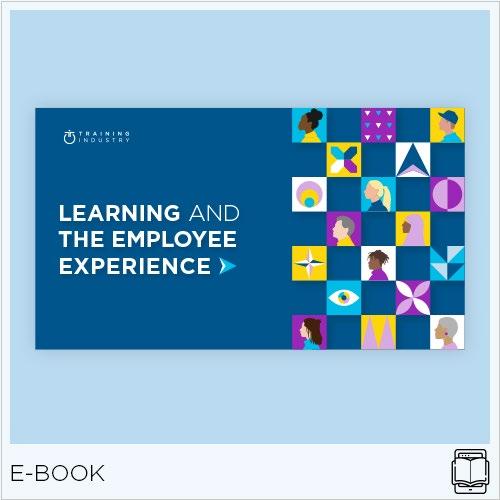


In today’s interconnected world, businesses are expanding their operations globally at an unprecedented pace. With the rise of international markets, remote work and global teams, it has become crucial for organizations to provide effective and localized training to keep learners engaged and inspired.
Conducting comprehensive and effective global training programs can often be a costly and time-consuming endeavor. Fortunately, there are simple strategies that businesses can use to reduce costs without compromising
on the effectiveness of their global training initiatives.
There are significant differences in language, culture, values and context across different regions. For instance, the work culture in Japan, with its emphasis on group harmony and collective identity, is completely different from France, where there is a greater emphasis on individualism and work-life balance.
For global training to be effective, it must be effectively localized. Localization involves adapting content and delivery to suit the specific needs, preferences and cultural nuances of different audiences.
Localization goes beyond just translation — it includes customizing all aspects of content including tone, colors, images, fonts, examples, numbers, currency, units, symbols and acronyms.
Different courses require different levels of localization. For example, technical training on how to use a machine doesn’t
require cultural adaptation and in-depth localization. However, a course on the prevention of sexual harassment needs every aspect from language and tone to examples and images and dialogue to be effective.
Similarly, some regions have similar work culture, language and context and the level of localization needed is low. If a U.S. company is localizing a course for learners in the U.K., in most cases, just the spelling, measurements, currency and expressions need to be localized. If they are localizing a course for a team in the United Arab Emirates, on the other hand, they might need to localize examples, images, colors and tone in addition to a full translation.
Treating localization as an afterthought is a common mistake made by many companies. By proactively planning for localization during the initial learning design phase, organizations can make informed decisions that save time and costs in the long term. Consider the following:
The most common issue when it comes to localization is the difficulty in exporting the content in a way that can be easily translated. Pick or create a learning management system (LMS) that can export content in an XLIFF or other editable format for easy localization.
Keep the source files and packages for your images, charts, diagrams, PDFs
and videos. If you use an external vendor, make sure to get all the source files from them. In the absence of source files, assets need to be recreated — an expensive and timeconsuming exercise.
If you outsource course development to an external vendor, make sure to get the source files from them in the format of the authoring tools they used to create the course. If you don’t have these, it will be impossible to edit or translate your files and new versions will have to be created from scratch.
When text is embedded into images, extracting, translating and reinserting it becomes difficult. Keep text outside your images and diagrams as much as possible. If you can’t, make sure you have the editable source files for all your images.
Keep the source scripts for your video narrations, subtitles and audio. If you don’t keep these, they will need to be transcribed during localization, adding time and cost.
Multimedia like animations, charts and images cost more money and time to localize. Keep multimedia use to a minimum. When you do use it, make sure you keep the editable source files.
When you translate your content from English into other languages, typically
content expands anywhere between 10-200% depending on the target language. For example, a sentence can expand up to 150% when translated from English to Malayalam.
When you are designing your buttons, slides and assessments, leave room for text expansion in the source files.
These are a nightmare to localize and often get misinterpreted or poorly translated. When authoring your content, avoid jokes, idioms, cultural references, sports references and non-standard acronyms as much as possible.
Video can be an effective modality, by itself or when blended into other learning experiences. Most training modules made today contain a mix of text and video-based content.
Video content is much harder to adapt for global learners — you need to take into account accents, pace of speech, body language and on-screen text (OST). The most expensive part of learning localization is that video localization and companies have to choose between adding translated subtitles versus adding voiceovers.
Here are the two main factors to consider when making the choice between subtitles and voiceover:
• EPI of the region : If the region has a high English proficiency index (EPI), subtitles are usually good enough. The Netherlands,
TREATING
AFTERTHOUGHT IS A COMMON MISTAKE MADE BY MANY COMPANIES.
the Nordics and Singapore the highest EPI and can easily follow English dialogues with subtitles in their native language to improve comprehension.
• Target audience : If your training is for a software engineering team, it is likely they have a high level of education and technology exposure. On the other hand, if your audience is truck drivers or factory workers, they may have a lower level of tech fluency.
For audiences with low tech fluency, audio should be translated for training to be effective.
Most companies test both and see whether voiceover localization leads to more effective learning through assessments and learner engagement rates.
Training is well-localized when a learner feels like it was created just for them. To make training effective, it is important to provide examples and case studies from local teams, clients and events.
For example, if you are localizing safety training for a factory in India, use examples of things that are right and wrong in the regional factories. You can include case studies, pictures and stories that happened in the region to make the training more relatable and effective.
Context and local examples become especially important when the training is behavior- and/or culture-related, like sexual harassment prevention or diversity, equity and inclusion (DEI) trainings. The incidents, issues, stories and case studies need to be local so learners relate to and apply the learnings.
You can even add videos from local managers and personalized messages from company leaders so your global team is engaged and inspired to learn.
Adapting your training for global learners can be a herculean task; each region has its nuances and presents unique challenges. It can be difficult to correctly assess learner requirements and reactions to content in advance.
A lot of experimentation and testing is needed to figure out the right localization formula for different regions. Do they need subtitles? Should currencies and measurements be localized? How does the speaker’s accent affect understanding? Does a formal or casual tone work better?
One mistake companies often make is localizing and launching all their modules in one go.
Big training courses cost thousands of dollars and can take several months (or even years) to localize. The best approach (if you have the time), is to localize one module or one part of your training and test it with learners. Get feedback on the translations and the comprehension, do assessments and check learner engagement. Based on responses from your global teams, make changes and run more tests till you are satisfied with the results.
This is especially important if you are doing localization for the first time for a country. Every team and region is different and you need to experiment to understand what level of localization is needed for effective learning.
Using this approach can save you a lot of time and money that might go into correcting or completely redoing full courses. It will also improve learner experience, engagement and course completion rates.
Reducing costs and increasing the effectiveness of global training programs are crucial for organizations operating in today’s interconnected world. Planning for localization from the outset, selecting suitable tools and platforms and minimizing multimedia use can significantly reduce costs and streamline the localization process. Moreover, seeking feedback, testing and refining the training modules iteratively ensures that the content resonates with global learners, leading to improved learning outcomes.
By implementing these costeffective and impactful approaches, organizations can achieve their training objectives while maximizing return on investment and creating a global workforce that is involved, inspired and interested in their work.
Every team and region is different.
T o F u t u r e - P r o o f i n g
Y o u r C o m p a n y
Access our latest skills guide to learn:
Six critical steps for mastering your skills strategy
How to identify skills gaps throughout your organization
How to unlock and utilize behavioral data to inform your upskilling and reskilling strategies
How to use skills as a currency
Tips for maintaining and continually evolving your overall skills program

opportunity to establish and nurture a positive and productive relationship with a new employee.
When done well, early onboarding activities lay the foundation for longterm success for both the employee and the employer. Effective onboarding can improve productivity, build loyalty, increase comfort and competence, help employees experience successes early on, demonstrate an organization’s commitment to supporting new employees and help them begin to form relationships — all of which increases engagement and helps reduce the likelihood of early turnover, which can be costly and disruptive.
Learning science principles help explain how learning happens. Learning engineering goes one step further and focuses on designing and implementing learning solutions within constraints imposed by different contexts.
Importantly, we can leverage evidencebased practices more typically found in “traditional” learning contexts to create more effective onboarding and training programs. Learning is learning, no matter what the environment. In doing so, organizations can enhance employees’ success.

We’ll explore three learning science principles and associated practices that, when effectively applied, can help support onboarding goals and solutions.
People learn best when they trust and feel supported, connected to, and accepted by the people and environment around them.
It is well-established that humans want and benefit from social connections and
build relationships with others at all levels of the organization are essential to fostering these critical components.
• On their first day, make sure employees know where to go and others are expecting them. No later than the day before the new employee is to report for work, send a message to current employees introducing the new employee.
• Make the first day as smooth as possible to pave the way for important learning to begin. Employees should have the equipment and access they need on the very first day of work. And they must know where to go for technical support, if necessary.
• Make their workspace and materials accessible. Not only should the physical workplace be accessible to all, but so should training materials and onboarding documents. This includes offering modified workspaces, tools to help people navigate digital
information and providing information in suitable formats for all individuals.
• Encourage new employees to share their perspectives on organizational norms and values. Give new hires specific opportunities to ask questions and pose new ideas that can help influence and shape organizational culture and processes.
• Incorporate social interactions into onboarding. Social connections help people recognize that they are not alone in any confusion they may have, help them feel more comfortable asking for help, illuminate different perspectives, build empathy and provide opportunities for collaboration. Socialization initiatives can be as simple as assigning a new employee a “buddy” or as complex as formal mentoring programs.
• Establish employee resource groups (ERGs) or affinity groups. ERGS are voluntary, employee-led groups with shared identities and interests, created with the goal of nurturing a sense of community, support and inclusivity in the workplace. They can provide a platform for growth and development opportunities, mentoring, professional development and social interaction.
• Involve managers in the onboarding process in meaningful ways. Managers can encourage and listen to questions and stress the importance of progress and improvement over time — all of which can help normalize mistakes and encourage trust.
Goals and expectations must be clearly articulated and feel achievable. They should be accompanied by opportunities to practice, learn, apply knowledge and receive timely feedback on progress.
Clear goals help employees focus their efforts by conveying what’s important and how success is defined. Further, they facilitate the process of evaluating progress and identifying any gaps or obstacles that may arise. Because learning accumulates gradually, employees must be given
many opportunities to practice, learn and respond to timely feedback in an iterative fashion.
• Provide clarity around the job role, expectations, accountabilities and boundaries.
• Help employees see how they connect to the big picture. Help employees see what they need to do to succeed, how expectations connect to the larger goals and the part they play in realizing the overall vision.
• Collaboratively establish clear, measurable and achievable shortterm goals. Short-term goals provide opportunities for employees to make progress and experience small wins. Over time, tasks can increase in complexity and level of responsibility.

• Nurture employees’ sense of confidence, competence and selfefficacy. Help new employees articulate and understand their strengths and how they can be applied within their job. Progressively more difficult tasks and challenges help build self-efficacy, as can breaking down projects and tasks into manageable components. Together, these approaches can help employees to develop and maintain a growth mindset.
• Watch for signs that new employees are struggling. If employees perceive tasks to be “over their heads,” they may need reassurance and support to restore confidence and motivation. One strategy is to encourage people to reflect on times when they have surmounted similar challenges and help build a recognition and appreciation for the fact that they can grow and learn with practice. Share examples of others who overcame similar challenges.
• Schedule (and keep) regular, one-onone check-ins. These touchpoints are important for assuring new employees that they are on track (or letting them know if they are not) and providing clarity on how to close any gaps. These conversations also support a smooth transition into their new role by helping
managers and employees to get to know each other better and identifying roadblocks as quickly as possible.
New learning builds on prior knowledge. To optimally provide a foundation for future learning, space out learning opportunities, take care not to overwhelm and provide novices with appropriate scaffolding to guide their learning.
Deep learning involves more than simply attaching new concepts to existing knowledge; it incorporates conceptual changes and the creation of rich, integrated knowledge structures. Effective teaching requires figuring out what learners already know about a concept and then finding ways to build on and develop that knowledge.
• Develop and follow a standard, documented onboarding procedure, maintaining an onboarding checklist

Without a solid start,it is easy for new employees to become disengaged.
for each new employee. This helps to ensure that important things are not skipped or given short shrift.
• Provide a roadmap of the first few days so new employees know what to expect. Include agendas for the first week and the first month.
• Subdivide required training into manageable chunks that are logically sequenced to support future learning. Space must intentionally be built into learning opportunities to allow employees time to learn foundational information and skills in a meaningful way.
• For training on complex job tasks, allow employees to practice component skills before combining them. Prior to teaching an entire task or process, isolate the most important component skills and decide which needs to be learned and practiced first.
• Create resources employees can reference as needed. These can include important job-related information that employees are not expected to memorize. For example, common policies, procedures, terminology, contact information and basic information on an organization’s products and services. Also, a glossary
of industry or organization-specific terms and acronyms is essential.
Creating and implementing onboarding programs and processes using learning science principles is an important first step. Evaluating the effectiveness of each part of these programs, however, requires a process for the collection and analysis of feedback, accompanied by a process for incorporating improvements. Moreover, organizations and cultures evolve over time. As expectations for new employees and the organization as a whole change, organizations must engage in consistent review, evaluation and revision of the onboarding experiences of new employees.
In traditional learning contexts, the more students that are involved in the design of curricula and engaged in the improvement of courses and teaching, the greater their sense of agency and ownership for their learning. In the workplace learning context, this also holds true. Ask current employees about their onboarding experience. Ask how their first weeks or months could have been improved or what they wish their manager, or others, had done or told them during that time.
This feedback can inform and help drive continuous quality improvement.
Truly setting new employees up for success is complex and nuanced — much more so than it may appear. The benefits of doing so, however, are significant for both employee and employer.
At the end of a successful onboarding period, an employee should have a clear sense of their role and expectations others have of them; their key strengths and capabilities and how they fit into the broader organizational vision; and how they can expect to grow and develop in their current role and beyond. By prioritizing strategies that foster meaningful learning from the beginning, organizations can set the stage for longterm employee success.
Julia Phelan, Ph.D., is the co-founder of To Eleven, an innovative education consultancy firm that partners with individuals and organizations to design and implement effective learning experiences grounded in science, human behavior and evidence-based principles to move all learners forward. Email Julia.

Clear goals help employees focus.
Learning and Development (L&D) is on the cusp of a major digital transformation — teams can harness the power of AI-driven content intelligence to accelerate agile transformation in an era of talent scarcity.
Integrating talent, skills, and content intelligence, organizations can create hyper-individualized learning experiences that drive growth for both the learner and the enterprise

Download our white paper to:
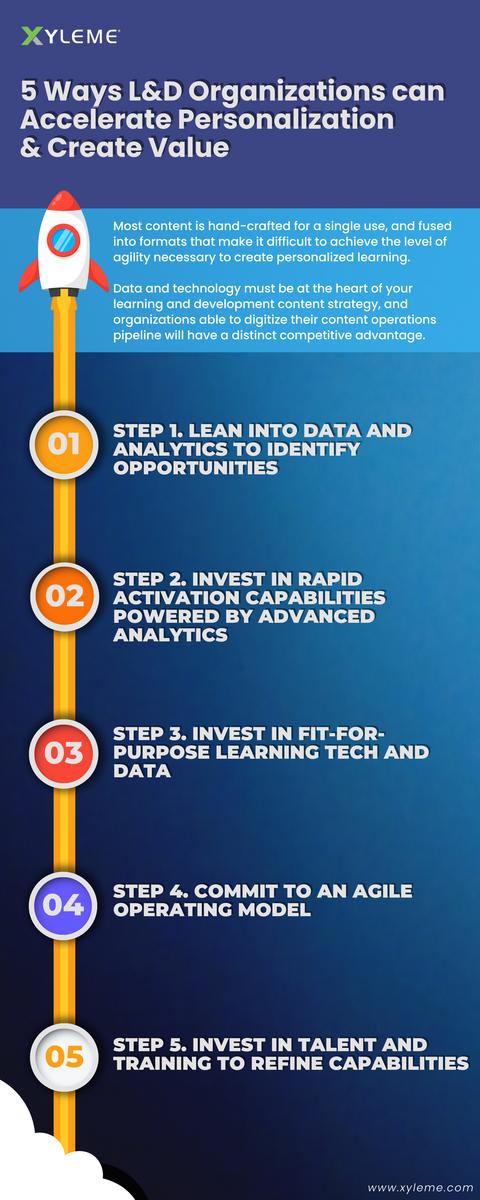
Predict workforce needs
Deploy learning in real-time


Empower your workforce
Drive organizational agility
GET THE WHITE PAPER
7 1 % of consumers expect personalized content experiences
& Company
TARGETED UPSKILLING MADE EASY:
DISCOVER HOW YOU CAN STRATEGICALLY
Introducing the learning leader’s ultimate course for conducting competency modeling within your organization.
JOIN US FOR THE FIRST SESSION
NOV. 15-16!
Take the first step toward becoming a trusted business partner by creating comprehensive competency models that enable targeted upskilling. Learn more about the course or register for the first session using discount code UPSKILL10 to receive 10% off your purchase.
LEARN MORE CLAIM YOUR DISCOUNT
I recently had the opportunity to lead a Certified Professional in Training Management (CPTM™) alumni roundtable focused on transitioning your learning and development (L&D) career. The roundtable was chock full of sage advice, lessons learned and poignant questions about how to be successful during career shifts. Whether you’re a seasoned L&D professional looking for a change, you’ve recently experienced a layoff or termination, or you’re a newcomer interested in finding your footing in L&D, transitioning your career comes with a set of common challenges that can feel difficult to navigate. As such, I’m dedicating this column to sharing some of the wisdom shared during that roundtable.
First, ask yourself, “What aspects of L&D am I passionate about? Are there specific industries or sectors that intrigue me?” Next, survey your extended L&D network — review their job titles and talk to them about what’s great (and not so great) about the work they do. Be sure to assess your current skills, strengths and weaknesses in the context of the possibilities. Training Industry offers a self-assessment based on our Training Manager Competency Model; this is a great starting point if your career goals relate to L&D management.
Once you’ve identified your career goals and your current skills, you’re ready to start applying for jobs. But don’t neglect research at this stage.
Investigate the company, its mission and vision statements, its annual report and any recent press releases. Consider the implications of each for its L&D department and initiatives.
One of the biggest challenges transitioning careers relates to drawing connections between previous experiences and new positions. To identify your transferable skills, you have to understand your current skill set and then compare your strengths against the skills needed in the job role you’re seeking. Make a list of your skills and review the list sideby-side with the job posting to map out connections. Don’t be afraid to think outside of the box either — some of your experiences may not seem relevant (e.g., volunteering in your child’s classroom), but it’s worth considering the unique skills and strengths you demonstrated (e.g., managing competing needs and demands, assessing different skill levels and adjusting accordingly, etc.).
Do this with colleagues, friends and family and at networking events.
Finally, don’t neglect presentation. By designing an impactful resume and a LinkedIn profile that showcases your transferable skills, you’ll have a better chance of standing out from other applicants. Make sure to ask trusted colleagues and friends to review your resume, cover letter and other application materials and consider investing in a service or coach who can help by offering feedback on your application package.
As you’re applying for new positions, don’t forget to tailor your applications and cover letters to the specific role you’re applying for. By customizing your messaging, you can demonstrate how your skills and experiences are a perfect fit for the role you’re pursuing.
I hope that these tips help to get you started in your career transition! One final tip: Don’t be discouraged if you face rejection along the way. Transitioning careers can be challenging, but persistence and adaptability are key. Use each rejection as an opportunity to refine your approach and continue learning.
Once you’ve got your list of transferable skills and experience, you can prepare examples and practice conveying those examples in a clear and compelling way that emphasizes their relevance.
Amy DuVernet, Ph.D., CPTM, is the director of training and development at Training Industry, Inc., where she oversees all processes related to Training Industry’s courses for training professionals, including program development and evaluation. Email Amy.

DON’T BE DISCOURAGED IF YOU FACE REJECTION ALONG THE WAY.
Transform your learning team into a high-performing learning organization. 3 2 1
Equip your training personnel with the necessary language and tools to drive impactful business results.
Align your training goals with the goals of the businesses you support.
Organizations that employ certified training managers are 4x more likely to be rated above average. Contact us to learn more about how certifying your team can drive lasting business success.
Even as a child, I remember being horrified at the phrase, “killing two birds with one stone.” The otherwise gentle people in my life took on sinister personas when discussing matters of efficiency. So, imagine my delight when shortly after entering the workforce, a British colleague introduced the kinder and gentler alternative, “feeding two birds with one scone."
In today’s pressure-filled, fast-paced workplace, we tend to relish our “scones” — the singular actions that deliver multiple benefits. And for those in learning and development, a particularly tasty and useful one is connection — because connection feeds some of the most important and hungry birds in business, including learning, mental health and the clock.
It’s not news that humans learn an extraordinary amount of what they need to know when they connect with others. Social learning has long been recognized as a powerful alternative and complement to the traditional classroom. Formalized vehicles like rotations, job shadowing, coaching and mentoring all leverage connection for targeted personal and professional development.
It wasn’t until the COVID-19 pandemic introduced remote work on a broad scale that we fully understood the power of osmosis at the office. That’s why many hybrid and remote organizations are placing greater
emphasis on the human side of onboarding, elevating the quality of one-on-one conversations, creating communications channels related to non-work topics, establishing buddy systems and encouraging digitally supported co-working. These strategies offer the structure necessary to create what occurs organically when colocated.
Long before the COVID-19 pandemic, the United States was experiencing a devastating epidemic — one of loneliness
Social disconnection has physiological implications, affecting such things as blood pressure, immunity and inflammation. It even represents as great a health risk as obesity, physical inactivity and smoking up to 15 cigarettes per day.
The flip side of this, however, paints a more hopeful picture. Employees with a sense of connection are likely to enjoy greater motivation, engagement and productivity. (They’re also inclined to stick around longer.) Research suggests that social connection elevates resilience, reduces stress, and in turn burnout, one of today’s most pressing workplace concerns. All of which makes connection an effective and costeffective tool for organizations looking to improve well-being.
Escalating expectations continually bump up against lack of staffing, spreading employees in many sectors exceedingly thin. No wonder we hear “busy,” “lack of bandwidth,” and “over-extended” so frequently. As counterintuitive as it seems, connection might be the answer here, too. Research suggests that “spending time on others increases one’s feeling of time affluence.” When compared with other ways to spend time, connecting with others left those in this study with the subjective impression of more time. Does time seem to go by more quickly when immersed in conversation? Do we feel uplifted and energized after engaging with others? Does social support from colleagues leave us feeling more capable?
Whatever the mechanism, there seems to be an argument even for the most time-starved among us to engage in dialogue, offer to coach or mentor others or agree to attend that problem-solving meeting. Because connection feeds the clock by creating the impression of more hours in the day.
If you want to drive learning, well-being and a greater sense of time affluence, consider the scone of connection — a strategy that will nourish employees, the organization and yourself.
Julie Winkle Giulioni is the author of the bestselling books, “Promotions Are SO Yesterday” and “Help Them Grow or Watch Them Go.” Email Julie.

SOCIAL CONNECTION ELEVATES RESILIENCE AND REDUCES STRESS AND BURNOUT.

 SRINI PILLAY, M.D.
SRINI PILLAY, M.D.

Immersive learning offers an opportunity to learn skills more easily and in environments that could resemble real life, but it offers more than that, including increased satisfaction, engagement and self-efficacy. In fact, immersive environments may decrease anxiety and boost confidence. However, immersive learning also requires that a learner’s mindset is conducive to receiving and remembering new information. Let’s review some of the aspects of learners’ mindsets that can get in the way of effective immersive learning.
Stress and overwhelm: Even mild stress can decrease conscious selfcontrol. As a result, neural circuits shut down and mental paralysis can set in. Rather than learning new ways of doing things, people are more likely to stick to their old habits, sometimes without realizing this. While a certain amount of stress can improve attention and learning, stress can also decrease both, thereby compromising the benefits of immersive learning.
Worry: While general overwhelm and stress can disrupt learning, so can specific aspects of anxiety. Worry and rumination, the constant thinking about disturbing situations in personal relationships, prior mistakes, negative experiences and conversations or social interactions, are quite common. One study showed that 21% of people cannot stop doing this. This can make it difficult to recall training.
Inability to focus: Globally, about 5% of the workforce has attention
deficit hyperactivity disorder (ADHD), though in the US, this may be higher Not being able to focus, even in an immersive environment, can take a toll on a person’s learning as new information is likely to be missed.
Feeling paralyzed by work: Sometimes people feel paralyzed by their work, and new learning is not welcome. At other times, people have analysis paralysis and avoid doing anything.
Hopelessness: When people are in a state of despair, it’s difficult to focus on learning. Also, when people lack a growth mindset, even an immersive environment may not be able to improve their ability to learn.
thereby impacting learning. Encourage positive relationships among learners, as people are more likely to learn if they are in a positive relational environment. At Reulay, we have partnered with immersive learning companies like the leading enterprise virtual reality (VR) platform provider that has worked with Fortune 1000 companies including Bank of America, Verizon, MGM and Walmart to improve learning by offering sciencebacked, VR-based solutions designed to address the factors above. Simply spending 5-10 minutes in an environment that addresses this can have a significant positive impact. Our research at the Mayo Clinic demonstrated that 10 minutes in a relaxing VR environment can improve anxiety, emotional distress and focus.
However, for different people, the stressors will be different, and some people may worry, while others may lack focus. These solutions should be personalized to address the anxiety challenges of a specific learner.
Do not assume that immersive environments improve learning for everyone. People who are overwhelmed, worried, unfocused, tense, paralyzed or hopeless may find it difficult to learn, even in an immersive environment.
Encourage a growth mindset and possibility thinking, so that people are open to the possibility of learning and benefiting from new things. Workload matters in an immersive environment, as heavy workloads can cause stress,
Learning does not happen automatically just because it is immersive. Anxiety, worry, inattention, tension, paralysis and lack of a growth mindset must all be addressed for learning to be optimal.
Dr. Srini Pillay is the CEO of NeuroBusiness Group. He is a Harvardtrained psychiatrist and neuroscientist, on the Consortium for Learning Innovation at McKinsey & Company, and author of “Tinker Dabble Doodle Try.” Srini is also co-founder, chief medical officer and chief learning officer of Reulay Email Srini.
LEARNING DOES NOT HAPPEN AUTOMATICALLY JUST BECAUSE IT IS IMMERSIVE.
The sales training market looks a lot different than it did a decade ago, and even five years ago. Today, sales training is by and large a technology-enabled sector of the corporate training market, with everything from mobile coaching solutions to customer relationship management (CRM)-integrated tools available to help sellers close more deals.
As buyer expectations and needs evolve, it’s perhaps unsurprising that investment in sales training is predicted to increase by 11.8% in 2023, with the top five industries sourcing sales training being technology, manufacturing, banking and finance, business services and consulting, and pharmaceuticals, according to Training Industry research
Founded in 1979, Richardson Sales Performance (“Richardson”) has long been a key player in the sales training market, proving its ability to keep pace with advancements in technology and other shifts. In July, Truelink Capital (“Truelink”), a middle market private equity firm, announced its acquisition of Richardson, further establishing Richardson as a leading sales training company. Let’s consider the acquisition in more detail.
Truelink’s acquisition of Richardson benefits both companies. Truelink targets companies in the technologyenabled services sector, so Richardson’s technology solutions, as well as its breadth of content, global footprint and client portfolio, were appealing, says Andrea Grodnitzky, Richardson’s chief marketing officer.
Truelink takes an operational approach to help companies adapt, meet current landscape challenges and grow, “and that’s really how they intend to support Richardson,” Grodnitzky says.
The acquisition also means that Richardson has the resources to continue growing its global reach through M&A activity, which Grodnitzky says will be a focus area for the company moving forward.
Richardson’s competitive advantage lies in three key factors: its technology, its content and its global reach.
• Technology: The company’s range of technology-enabled solutions allows it to reach customers where they are. Its Accelerate Workflow Tools integrate directly into a CRM and allow sellers to rate opportunities, set goals, and receive real-time recommendations and coaching. And QuickCheck™, Richardson’s mobile sales training reinforcement solution, works to sustain learning over time.
• Content : Richardson built its Connected Selling Curriculum™ so that its content “works together and builds upon each other across roles and capabilities,” Grodnitzky says. Because selling is “a human-to-human interaction,” the curriculum is rooted in behavioral science, which helps to drive behavior change.
• Global reach: Richardson operates in multiple markets worldwide, including in the U.S., Europe, Middle East and Africa (EMEA), Latin America (LATAM),
Asia Pacific, Australia and New Zealand (APAC) and Canada (CA).
Too often, organizations invest in sales training that is generic and “disconnected from the world that their reps live in” — a challenge that Grodnitzky refers to as “The Big Disconnect.”
To combat this challenge, Richardson is focused on three priorities: developing more adaptable content; offering technology-enabled learning solutions that are engaging, easy to use and accessible in the flow of work; and delivering more visible progress (e.g., tracking key performance indicators and other learning metrics and “serving those up to customers”), Grodnitzky says. Focusing on these areas will help Richarson deliver more effective, relevant sales training that drives results.
Looking ahead, Grodnitzky says that Richarson is excited to keep working with Truelink to grow and innovate its offerings. In addition, “There’s opportunities for Richardson to make some strategic acquisitions that can not just help us grow but help us bring a better solution to our customers.” This may mean looking at companies leveraging artificial intelligence (AI) as well as companies specializing in supporting broader revenue teams, which would help Richarson extend its reach and position it for future success.
Sarah Gallo, CPTM, is a senior editor at Training Industry, Inc., and co-host of “The Business of Learning,” the Training Industry podcast. Email Sarah
ELB Learning, the worldwide market leader, announced a new corporate learning and development game, created in partnership with CyberCatch, the industry-leading cybersecurity compliance and cyber risk mitigation solution provider. The gamified course allows learners to role-play as hackers, learning common tactics, techniques and procedures that are used to exploit vulnerabilities.
Docebo , the leading provider of learning platforms with a foundation in artificial intelligence and innovation, announced its partnership with Google Cloud. The partnership will enhance Docebo’s ability to train enterprise workforces, customers and related communities with generative AI technology.
Cognota, the leading provider of LearnOps software, announced a strategic collaboration with ROI Institute, the industry leader in measurement and evaluation, to design and implement a cutting-edge learning management feature. The collaboration will revolutionize the way corporate learning and development leaders measure the effectiveness and impact of their learning investments.
Blanchard, the global pioneer in leadership development, consulting and coaching, announced a partnership with OpenSesame, the leading SaaS global eLearning innovator, to include hundreds of Blanchard’s digital assets, videos and microlearning on OpenSesame’s catalog of eLearning courses. The move makes Blanchard’s material available in a flexible, self-paced format.
Schoox, the provider of learning management and talent development software, announced the addition of coaching to its all-in-one learning platform. The new feature includes a configurable, mobile-ready way for organizations to guide learners through skill development in a real-world context, address performance gaps and set up regular mentoring and career development discussions.
LMS365, the leading AI-powered learning platform in the Microsoft 365 suite, announced new AI capabilities that will
deliver tailored and streamlined learning experiences for employees and groundbreaking course creation capabilities for L&D leaders. The new capabilities will empower organizations to drive skills development in a more personalized and effective way.
Udemy, the company devoted to improving lives through learning, announced the availability of its new badging offering. Rolled out as part of their new integrated skills framework methodology, the new offering is designed to help organizations make sense of the complex skills landscape so that they can future-proof their workforce and keep pace with innovation.
Mind Tools for Business , the provider of accessible, on-demand performance tools and resources, announced a partnership with Guider, the award-winning provider of diversity and inclusion, reverse mentoring and virtual mentoring solutions, to give clients access to seamless mentor matching, monitoring and reporting services.
MPS Interactive Systems, the premium global B2B learning company, announced a new partnership with Liberate Learning through their strategic edtech investment. The collaboration is set to drive Liberate’s mission to provide superior educational technology solutions to the AsiaPacific market.
Wipro Limited, the leading technology services and consulting company, announced the launch of Wipro ai360, a comprehensive, AI-first innovation ecosystem. ai360 builds on Wipro’s decade-long investments in artificial intelligence (AI) with the goal of integrating AI into every platform, tool and solution used internally and offered to clients. and growth hacking.
VIEW THE LISTS trainingindustry.com/top-training-companies


The Top 20 Companies are a service provided by Training Industry, Inc. Because of the diversity of services offered, no attempt is made to rank Top 20 lists.


